To visit a German castle is to step into a fairy tale setting, where castles sit atop high mountain peaks, their towers and turrets reaching to the sky. Germany is famous for its castles, with their pasts filled with knights, dukes and the devastation of wars.
Like everywhere, most castles in Germany were built on hills, enabling the occupants of yore to see invaders approaching. Not all the castles in Germany, however, were successful at repelling foreign invaders, who frequently captured and destroyed them.
The castles, which boast a rich history, have been restored to their former glory and, in some cases, are lived in by families of the founders. Their treasures include previous artifacts, paintings, furniture and weapons.
Plassenburg
Plassenburg is one of the most impressive castles in Germany and a symbol of the Bavarian city of Kulmbach. It was first mentioned in 1135. It was destroyed in 1554 at the end of the second Margravian war. The castle was later rebuilt by the architect Caspar Vischer as an impressive stronghold and as a huge palace.
Nuremberg Castle

This castle is situated on a sandstone rock in the north of the Bavarian city of Nuremberg. It comprises three sections: the Imperial castle (Kaiserburg), some buildings of the Burgraves of Nuremberg (Burggrafenburg), and the municipal buildings of the Imperial City at the eastern site (Reichsstädtische Bauten). The castle, together with the city walls, is considered to be one of Europe’s most formidable medieval fortifications.
Schloss Johannisburg
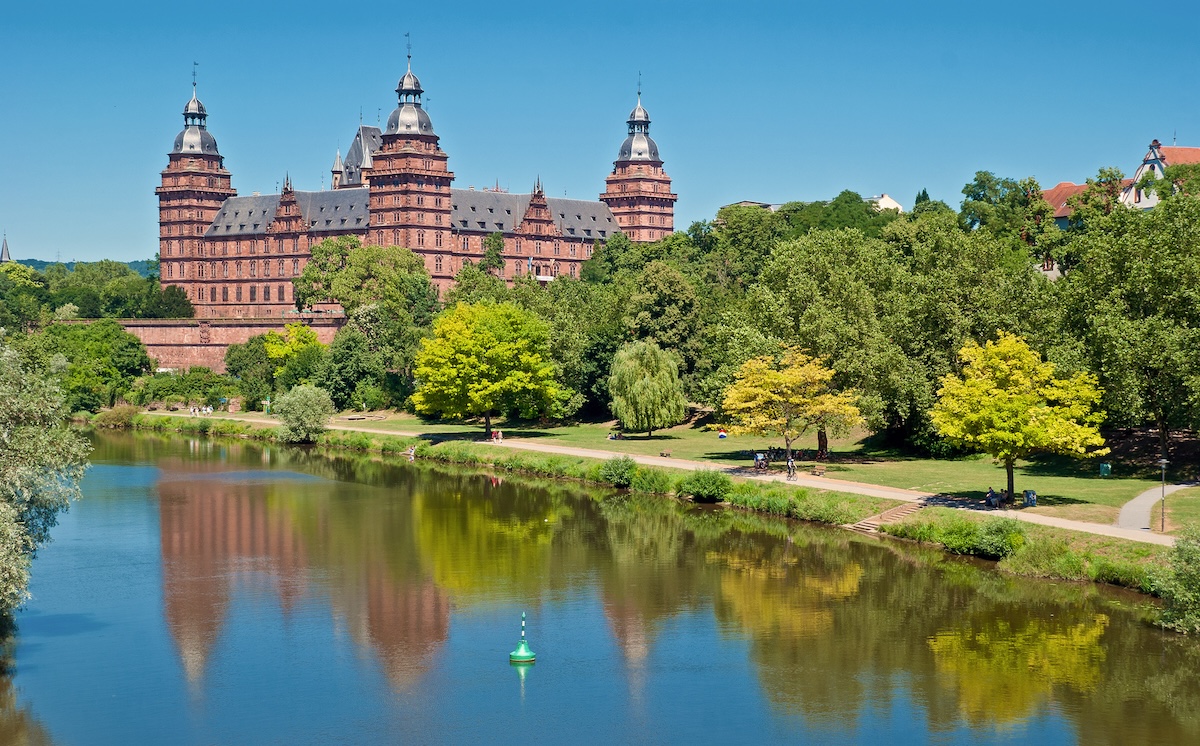
One of the most important buildings of the Renaissance period in Germany, Schloss Johannisburg is located in the Bavarian town of Aschaffenburg in Franconia. It was built between 1605 and 1614 by the architect Georg Ridinger. Until 1803, it was the second residence of the Prince Bishop of Mainz. The castle was nearly destroyed in the closing days of World War II and took about twenty years to fully restore.
Marienberg Fortress
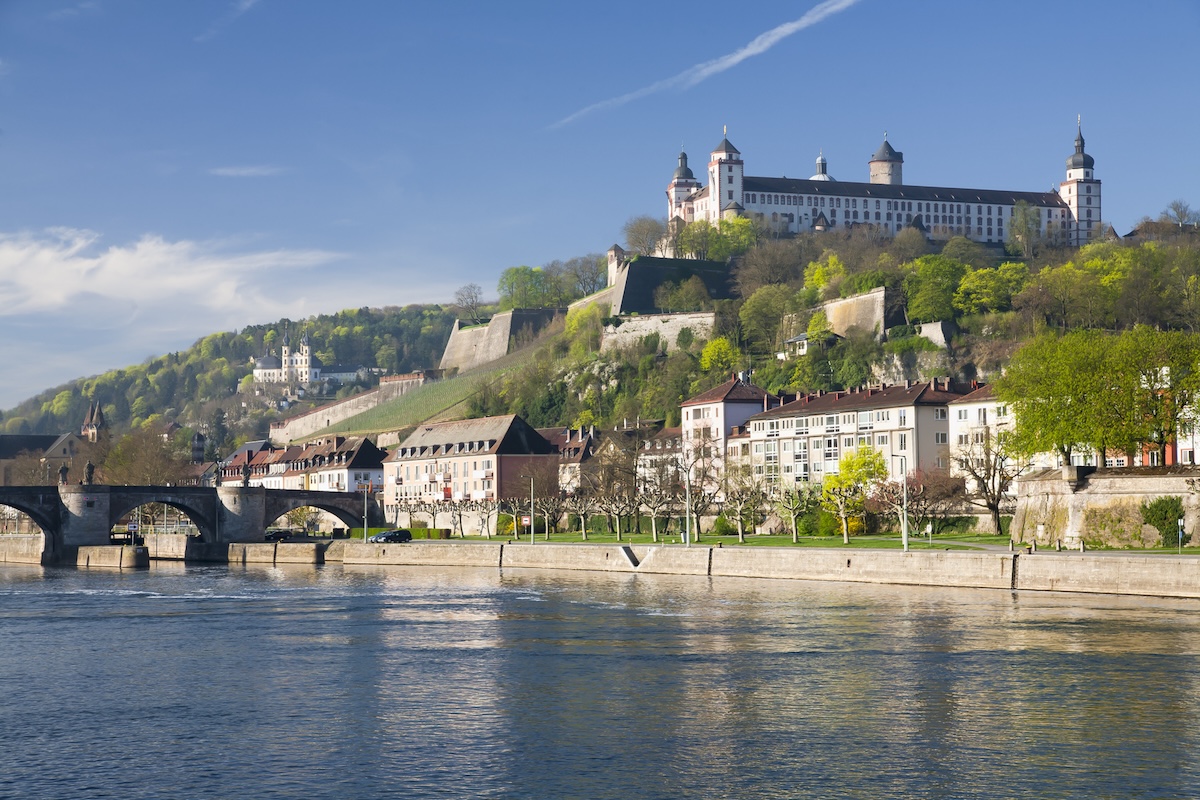
The mighty Fortress Marienberg is a symbol of Würzburg and has been a fort since ancient times. Most of the current structure was originally built in Renaissance and Baroque styles between the 16th and 18th centuries. After it ceased to serve as residence of the Bishops of Würzburg, the fortress saw repeated action in the wars of the late 18th and 19th centuries. It was severely damaged in WWII and only fully rebuilt in 1990.
Mespelbrunn Castle

Mespelbrunn Castle began as a simple house built on the water by an early 15th century knight. Located within the Spessart forest between Frankfurt and Wurzburg, the castle may lack the gingerbread look of other German castles, but its simple beauty makes it one of the most visited water castles in Germany. Indeed, it has been described as one of the loveliest castles in Europe.
This northern Bavaria castle is privately owned, but the family opens its doors to tourists throughout the year. Taking a walk on the paths throughout the castle grounds is highly recommended by past visitors.
Veste Coburg
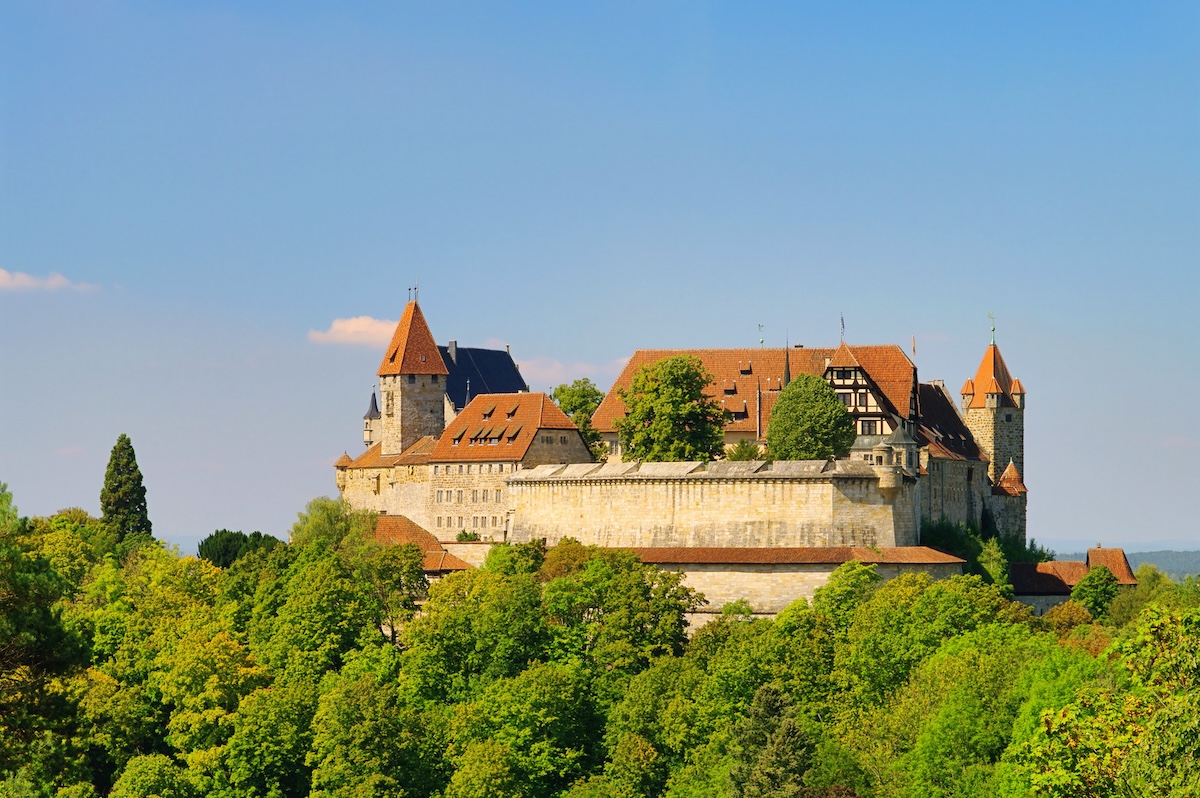
The Veste Coburg is one of Germany’s largest castles. It is situated on a hill above the city of Coburg. Within sight is the sister-castle of Veste Heldburg, once a hunting lodge of the Dukes of Coburg. Martin Luther lived in the Veste for a number of months during the Diet of Augsburg in 1530.
Callenberg Castle
Callenberg Castle is situated on a wooded hill near the city of Coburg, It was once a hunting lodge and summer residence and has long been the principal residence of the House of Saxe-Coburg and Gotha and is still owned by the same family. It is home to a large family chapel and a rifle museum.
Trausnitz Castle
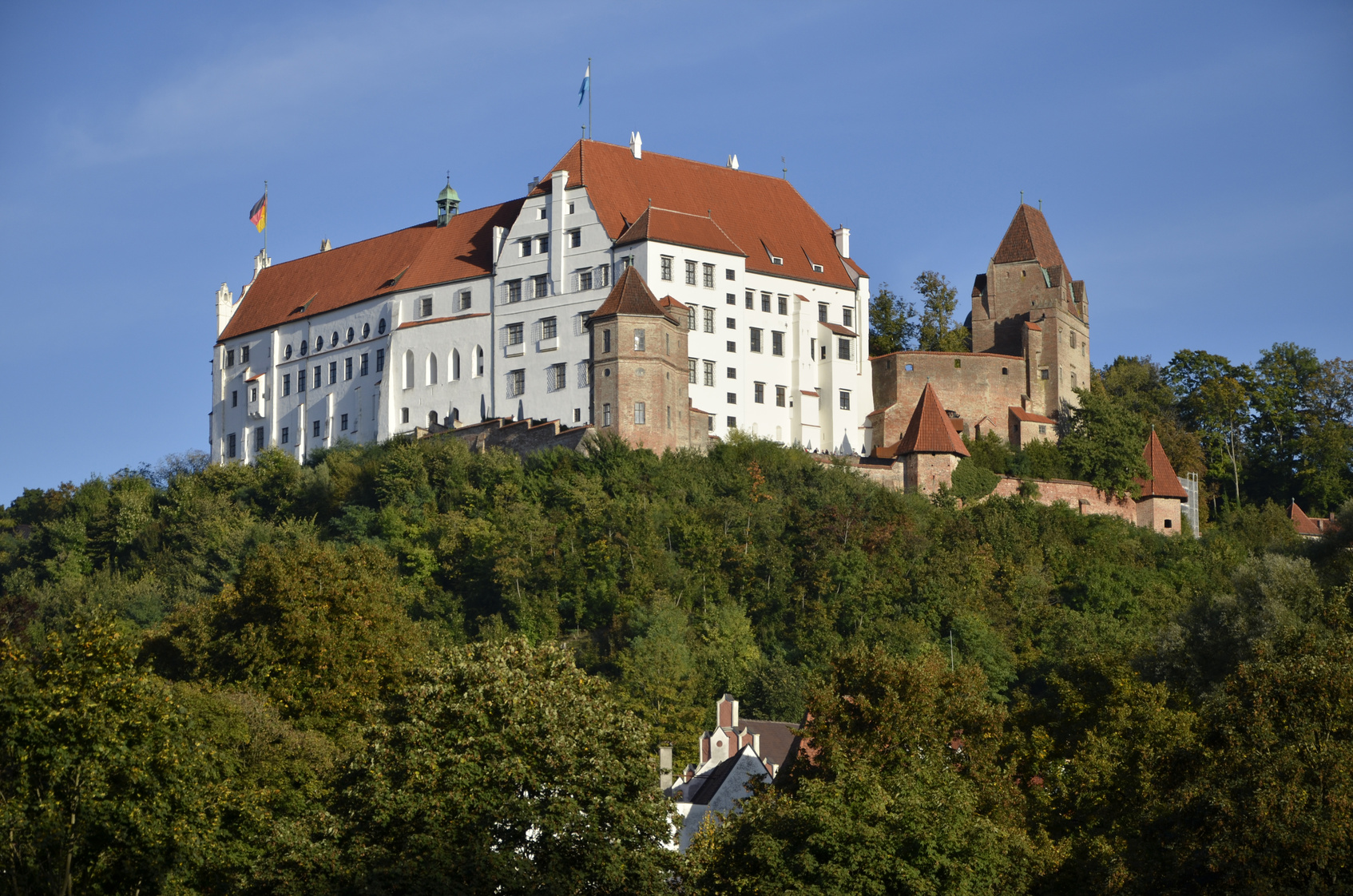
Trausnitz Castle is another Bavarian castle that offers stunning panoramic views of the countryside below; in turn, it can be seen from miles around. Up until the 16th century, it was called Landshut after the town in which it was located. Once the home of dukes, it was later used as a prison, a hospital, a military barracks, and a wool and silk factory. The castle has been restored after a devastating fire in 1961. A collection of ducal treasures can be seen today.
Willibaldsburg

The Willibaldsburg is a spur castle, built around the year 1353 in Upper Bavaria. The Altmühl river here forms a sharp bend which, due to the resulting ridge was an ideal spot for the medieval castle. Until the middle of the 18th century it was the representative castle and seat of Eichstätt’s prince-bishops.
Neuschwanstein Castle
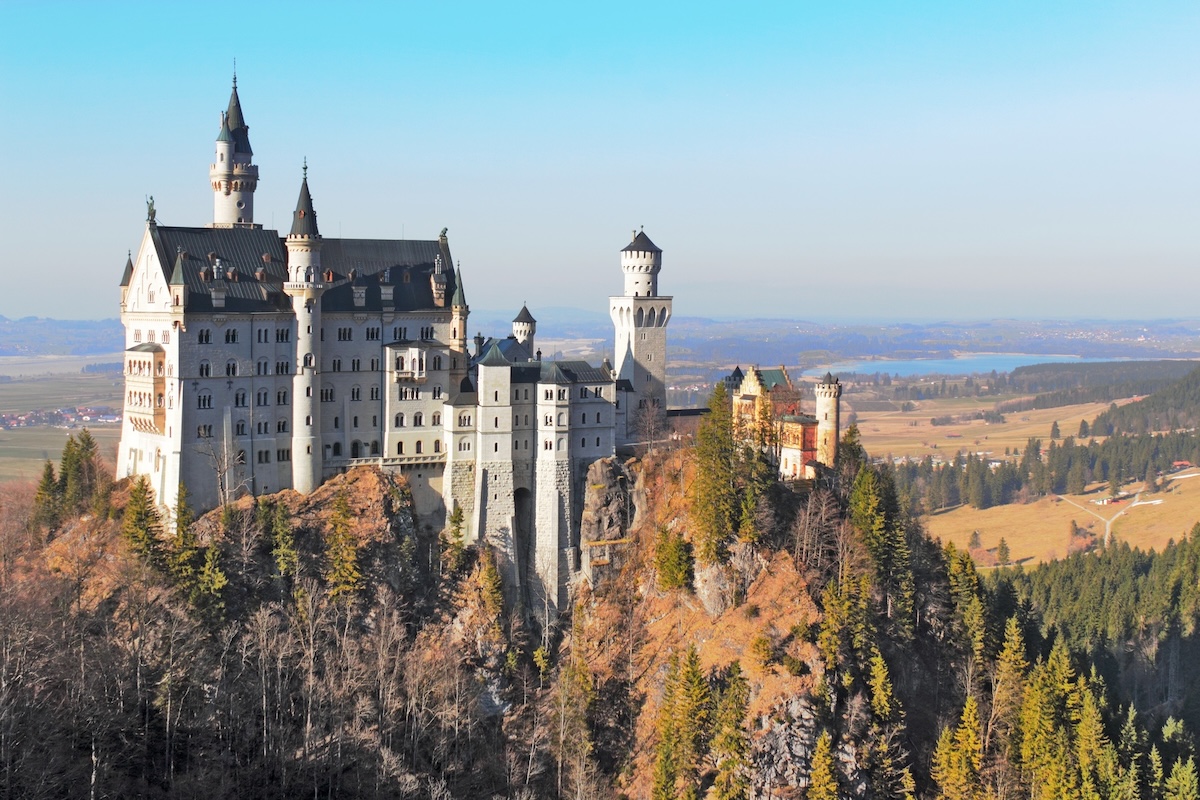
The most photographed building in Germany, Neuschwanstein Castle, is also one of Europe’s most popular tourist destinations. Nestled among the breathtaking beauty of the Bavarian Alps near the town of Fussen, this fairy-tale castle served as the inspiration behind Walt Disney’s Sleeping Beauty Castle.
Constructed in the late 1800s, Neuschwanstein was never built for defense purposes as most castles. Instead, this castle was created as a fanciful retreat for Ludwig II of Bavaria. Dazzling chandeliers and beautiful paintings adorn every room in the castle while the third floor is devoted to Ludwig’s fascination of swan scenes from operas by the famous composer Richard Wagner, whom Ludwig deeply admired.
Hohenschwangau Castle
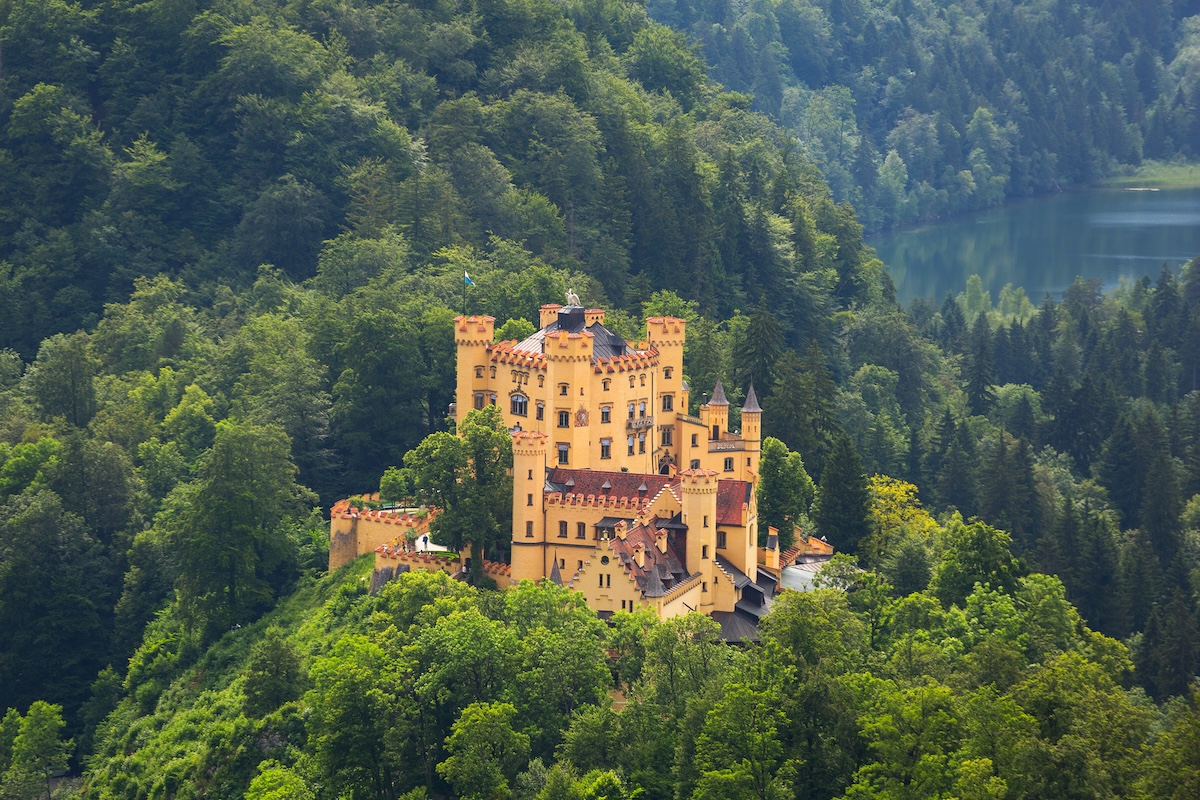
Hohenschwangau Castle is probably best known as the castle next to the world-famous Neuschwanstein Castle, but it has a unique and vibrant history all of its own. Hohenschwangau had its beginnings in the 12th century as the fortress Schwanstein. The family of knights who had founded the fortress died out by the 16th century. In 1832, crown prince Maximilian II of Bavaria, the father of Ludwig II, had the ruined castle of Schwanstein rebuilt in neo-gothic style.
When the work was complete, Maximillian used it as a hunting lodge, and for a summer palace. Ludwig II reigned after Maximillian died in 1864. He never married, so his mother remained at this home for the rest of her life. It is located in the village of Hohenschwangau near the town of Füssen.
Hohenzollern Castle
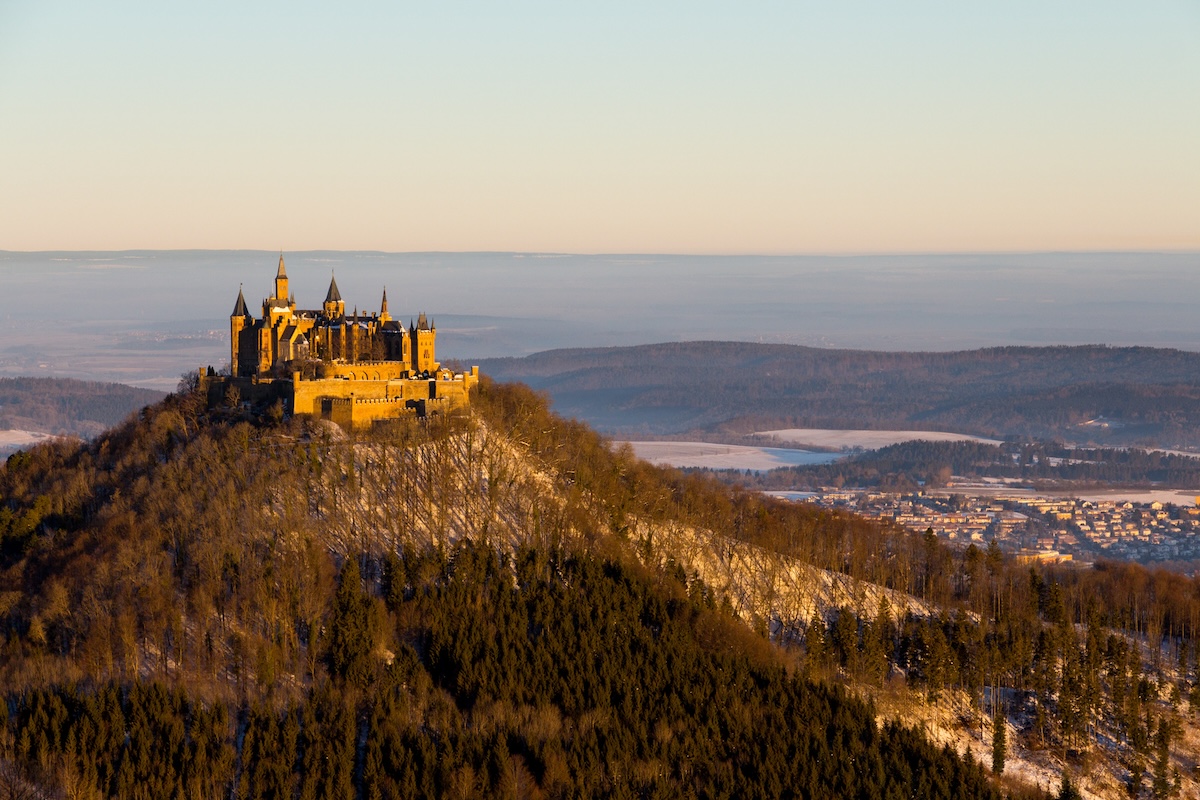
Sitting atop Mount Hohenzollern, the castle had its beginnings in the 11th century. The original castle was destroyed over the centuries with only the chapel remaining. The present castle was built in the mid-19th century by King Frederick William IV of Prussia.
Located 50 km (30 miles) south of Stuttgart, the castle is the ancestral home of the Hohenzollern family, from which emperors and kings have emerged. Today the castle is a museum unlike any other.
It is filled with treasures including the crown worn by Prussian kings and a uniform worn by Frederick the Great. One of the most visited castles in Germany, it is privately owned.
Burghausen Castle
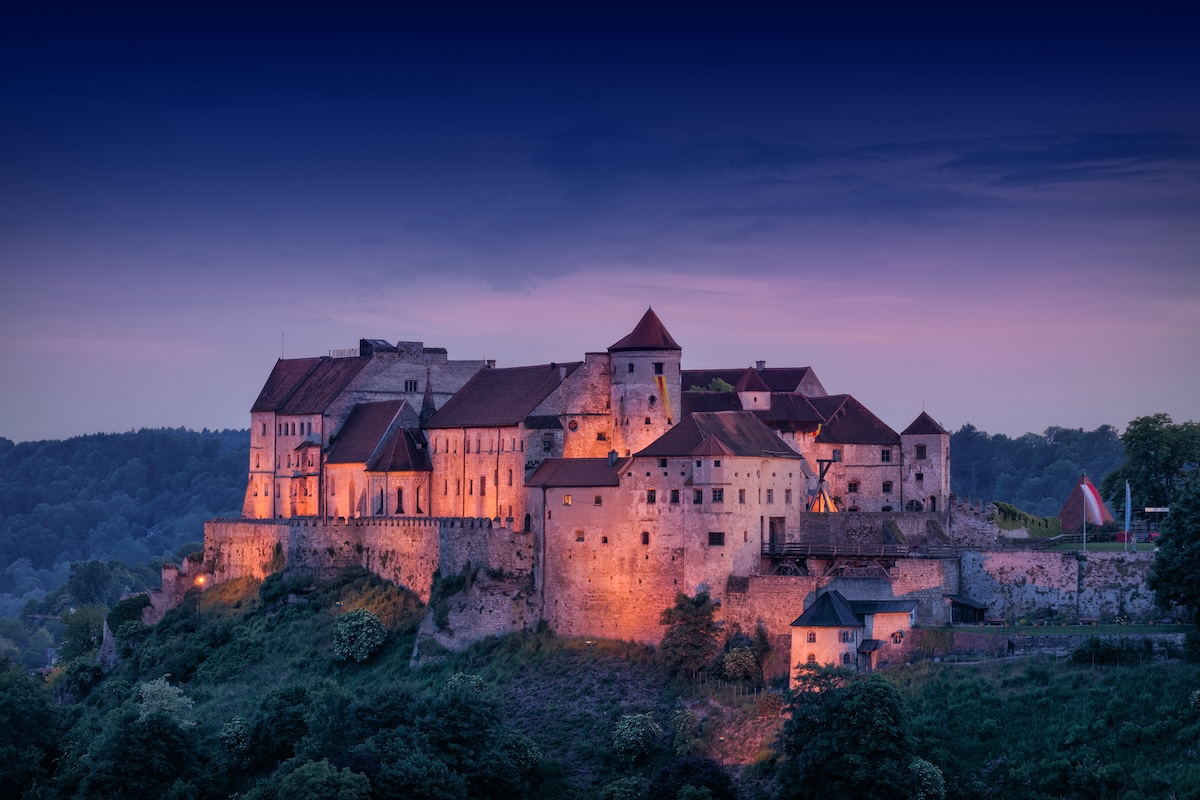
Travelers who are into big things definitely won’t want to miss Burghausen Castle, the largest castle in Europe and one of the largest castle complexes in the world. This Bavarian castle is more than 1,000 meters (3,300 feet) long and has six courtyards. During the Middle Ages, it was one of the strongest fortresses in Germany. This well-preserved castle is known for its collection of late Gothic panel paintings. It is open to public events, including weddings, today.
Hohenneuffen Castle
Unlike other German castles, Hohenneuffen Castle never found someone who loved it enough to restore it. As a result, this 12th century castle is mainly in ruins as it sits atop a large rock in the Swabian Alb in Germany’s Baden-Wurttemberg region. At one time, pieces of the castle were sold as building materials. The castle today has a restaurant and a medieval-style market, and hosts an annual running event. Admission is free.
Katzenstein Castle
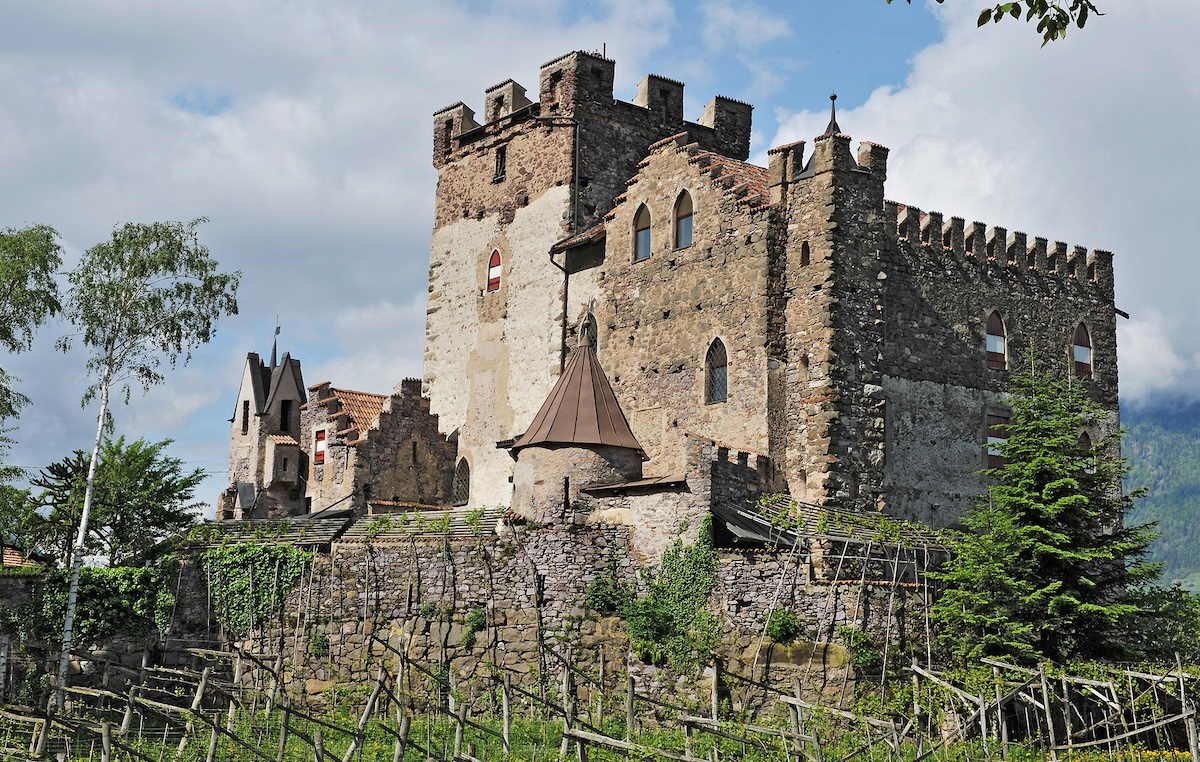
Katzenstein Castle is one of the oldest remaining castles from the Hohenstaufen dynasty. The castle was burned to the ground by French soldiers in 1648, at the end of the Thirty Years’ War. It was rebuilt 20 years later. The castle is open to visitors and contains several dining rooms as well as a few hotel rooms.
Heidelberg Castle
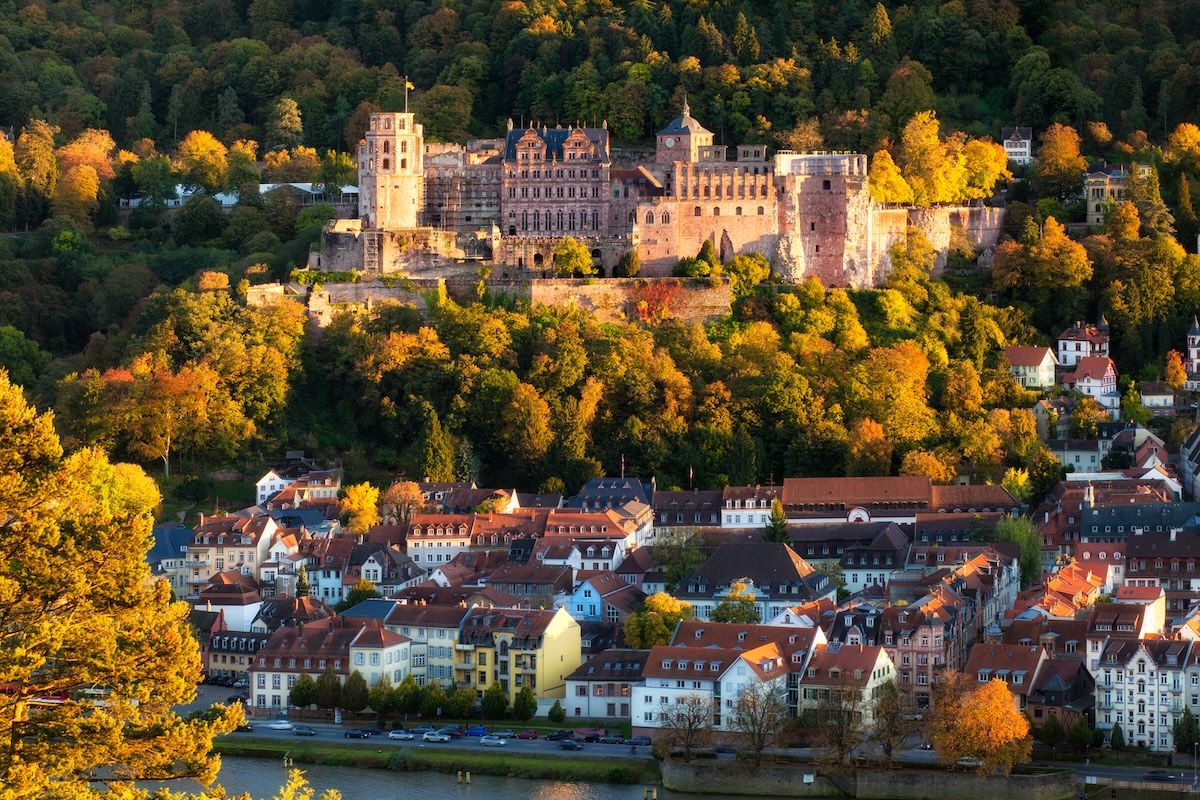
Heidelbeg castle is located 80 meters (260 ft) up the northern part of a hillside, and dominates the view of the old center of Heidelberg. The castle ruins are among the most important Renaissance structures north of the Alps. It has had a long and turbulent history since the earliest castle structure was built in the 13th century.
Having been totally destroyed during the Thirty Years War, and later by the French in the 17th century, the castle was struck by lightning in 1764 and even its stones were taken to build new houses in Heidelberg. All the subsequent rebuilding has led to a variety of architectural styles which adds to the castle’s charm.
Inzlingen Castle
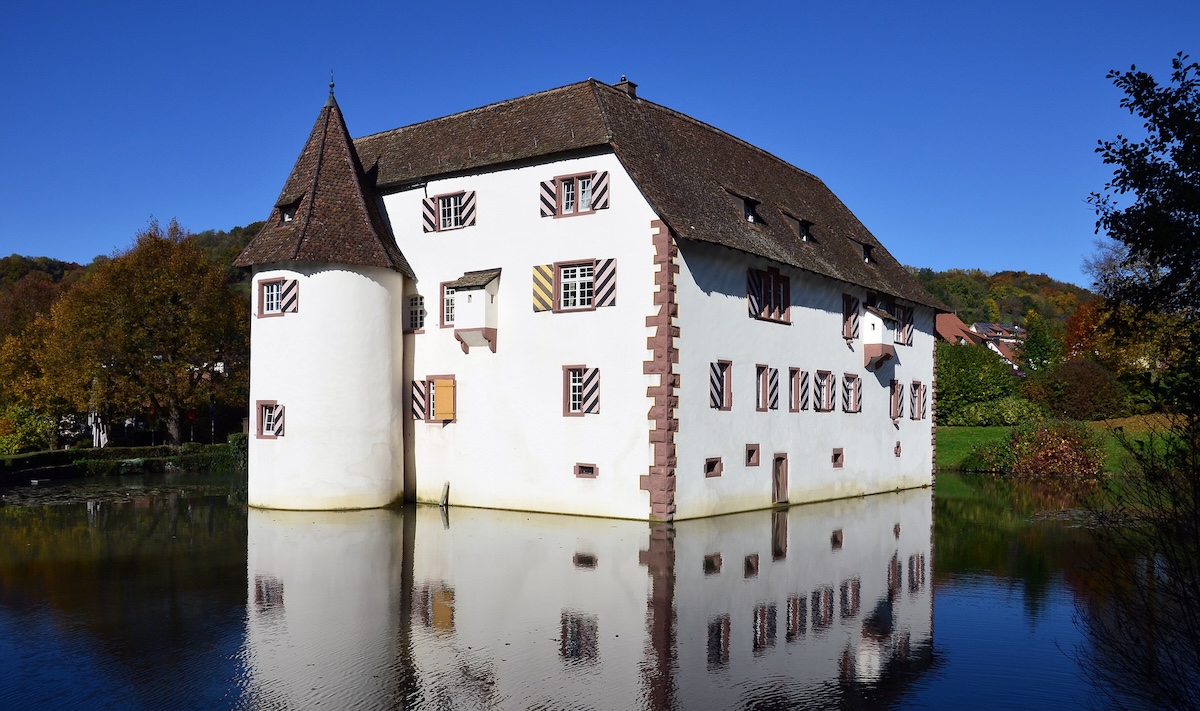
Inzlingen Castle is a medieval castle surrounded by a moat located in the very south-west of Germany just at the Swiss border. The origins of the castle cannot be clearly dated; the first written evidence dates to 1511. In the 19th century it was used as a farm house. Since 1978 it functions as the city hall of Inzlingen. There is also a restaurant within the castle.
Lichtenstein Castle
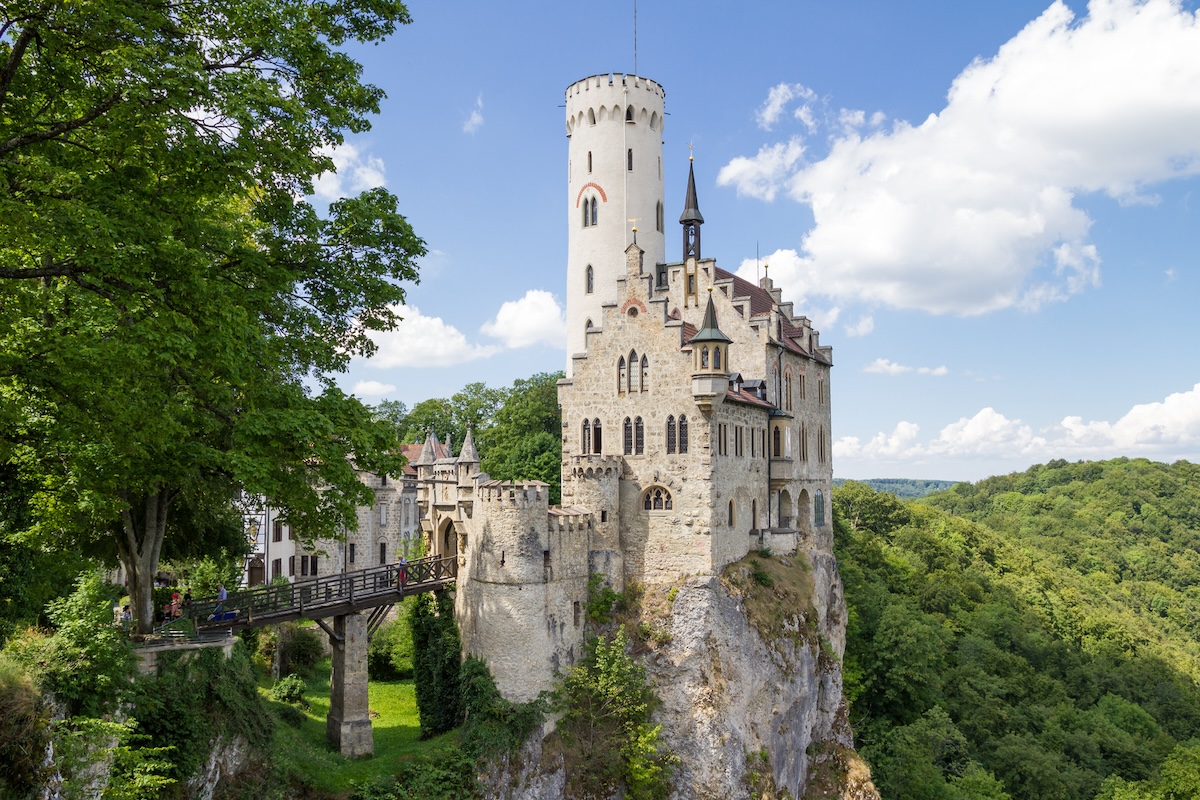
Lichtenstein Castle is one of Germany’s newer castles, built only in the 19th century to honor the medieval knights of Lichtenstein. A castle stood on the site as early as the 12th century, but fell into disrepair until the current castle was built. It stands boldly atop a hill, accessible by a stone bridge stretching to another hill. Located in the Swabian Alps near Honau, the Neo-Gothic castle is known for its collection of historic weapons and armor.
Schloss Heiligenberg
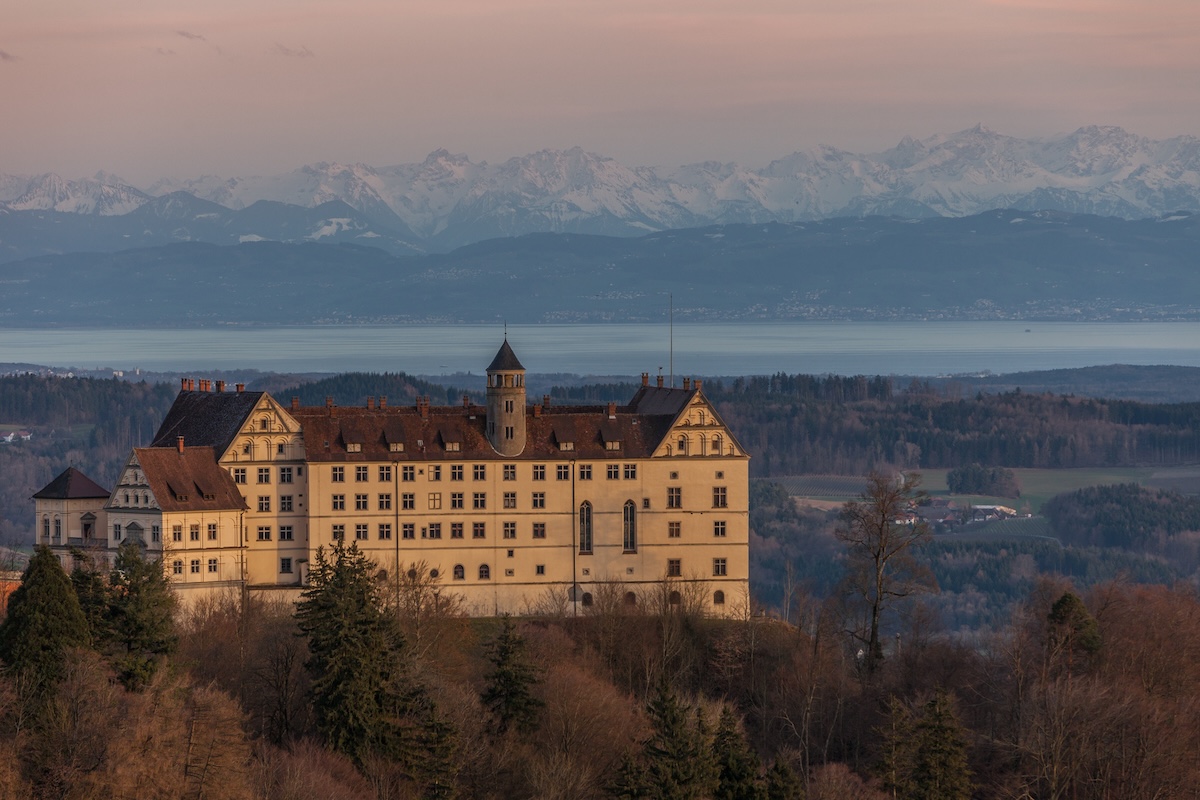
Schloss Heiligenberg is a Renaissance-style castle located north of the Bodensee. It is owned by the Fürstenberg family and is sited on a high plateau, with stunning views down onto the Bodensee and the Alps. Through a marriage in 1516, the burgh passed to the house of Fürstenberg in 1535. It is still owned by that family today.
Sigmaringen Castle
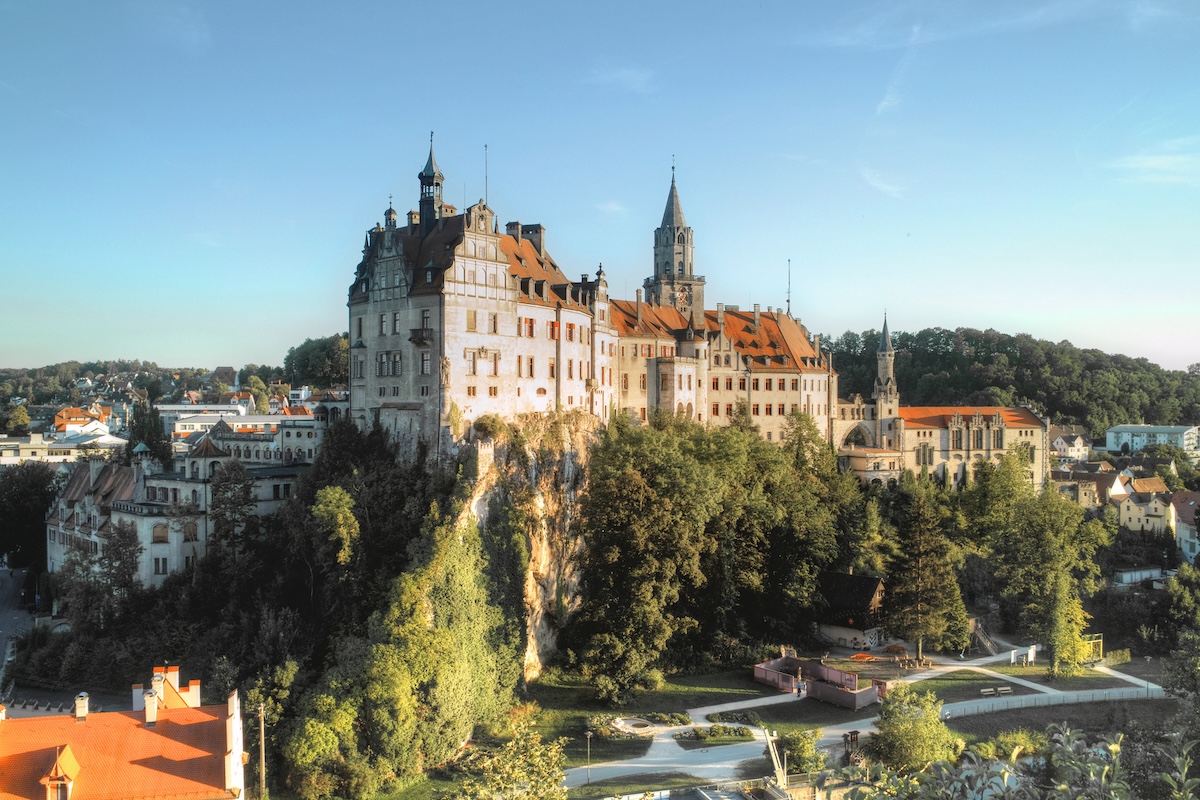
Situated in the Swabian Alb, the Sigmaringen Castle dominates the skyline of the town of Sigmaringen. The castle was rebuilt following a fire in 1893, and only the towers of the earlier medieval fortress remain. At the end of World War II, the castle was briefly the seat of the Vichy French Government after France was liberated by the Allies. The castle and museums may be visited throughout the year, but only on guided tours.
Frankenstein Castle
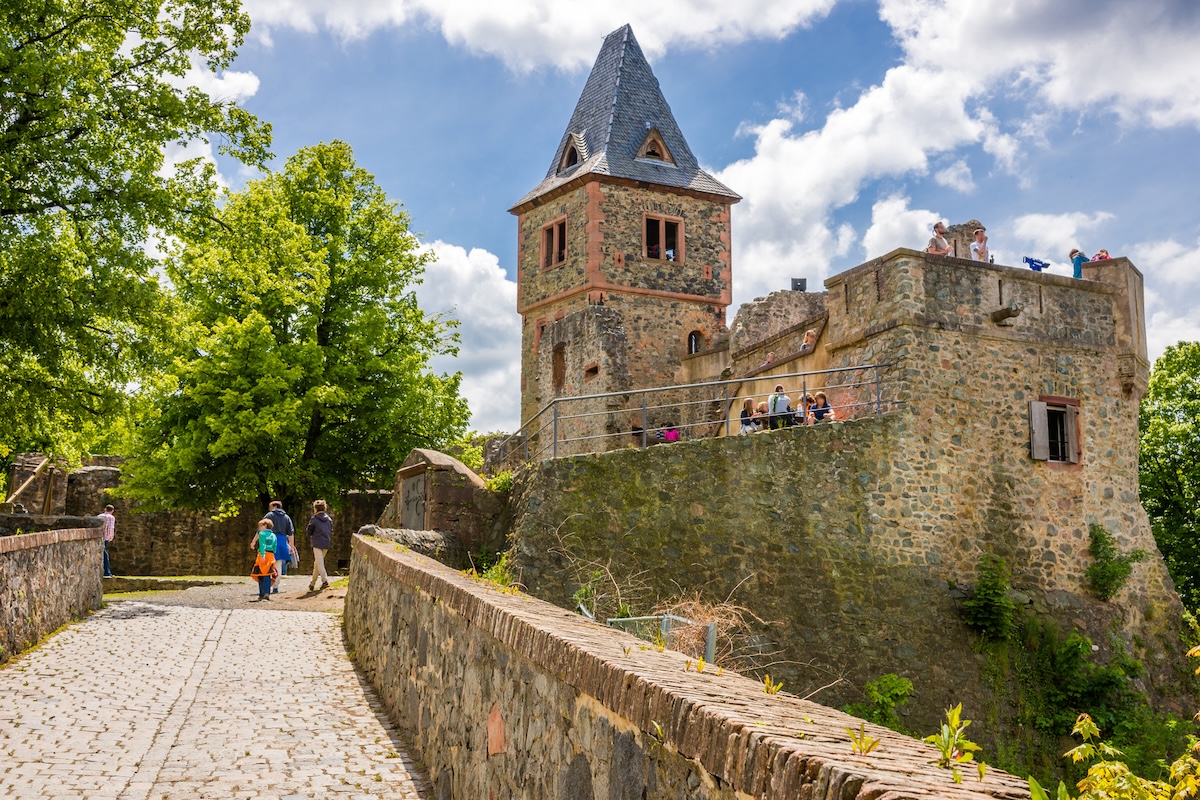
Frankenstein Castle has been around since the 13th century, but it wasn’t until Mary Shelley wrote her gothic novel Frankenstein in 1818 that the castle took on frightening dimensions, though legend has it the castle has been haunted for centuries. Legend also has it that an early resident died here after doing battle with a dragon. Located on a hill overlooking Darmstadt in southern Germany, the castle today hosts one of the biggest Halloween festivals in Europe.
Ehrenfels Castle

The ruined Ehrenfels Castle is located on the steep eastern bank above the Rihine Gorge amid extended vineyards. It was used as customs post controlling the shipping on the Rhine, supplemented by the Mouse Tower below at the river. Heavily damaged in the course of the Thirty Years’ War, the castle was finally devastated by French troops during the 1689 Siege of Mainz.
Quedlinburg Castle
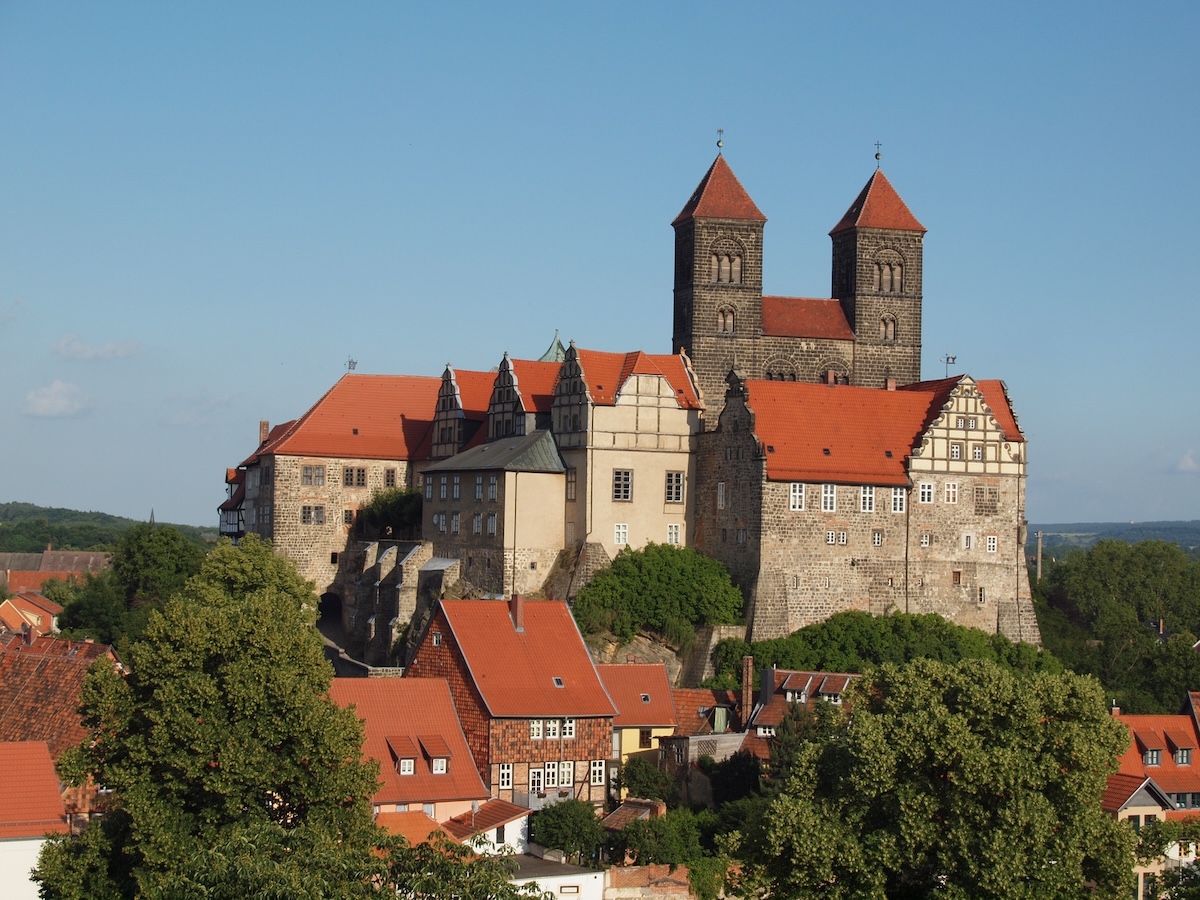
Quedlinburg Castle is a large Renaissance style building in the center of the old town. The castle dates from the 16th- to 17th centuries. Currently the castle is a museum, which shows off the restored rooms of the building, each with original furniture and art works.
Marburg Castle
Marburger Schloss was built in the 11th century as a fort. It became the first residence of Landgraviate of Hesse. Today the building is used partly as a museum and as an event site.
Celle Castle
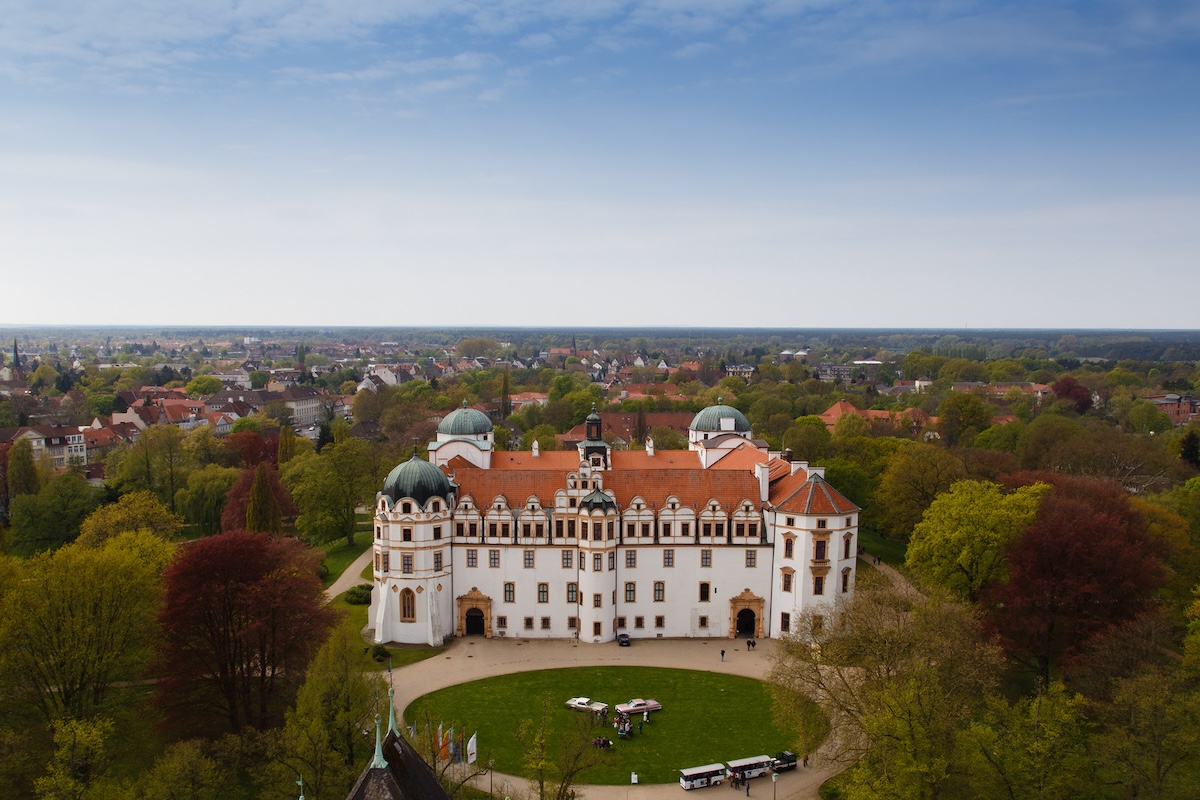
Sitting on an island surrounded by moats, Celle Castle was first referred to in 1315, when the Dukes of Brunswick-Lueneburg moved their residence from Lueneburg to Celle. In 1772, the banished Danish Queen Caroline Mathilde was imprisoned here as the result of her affair with a German court doctor. She lived here for three years until her death from scarlet fever in 1775.
Marienburg Castle
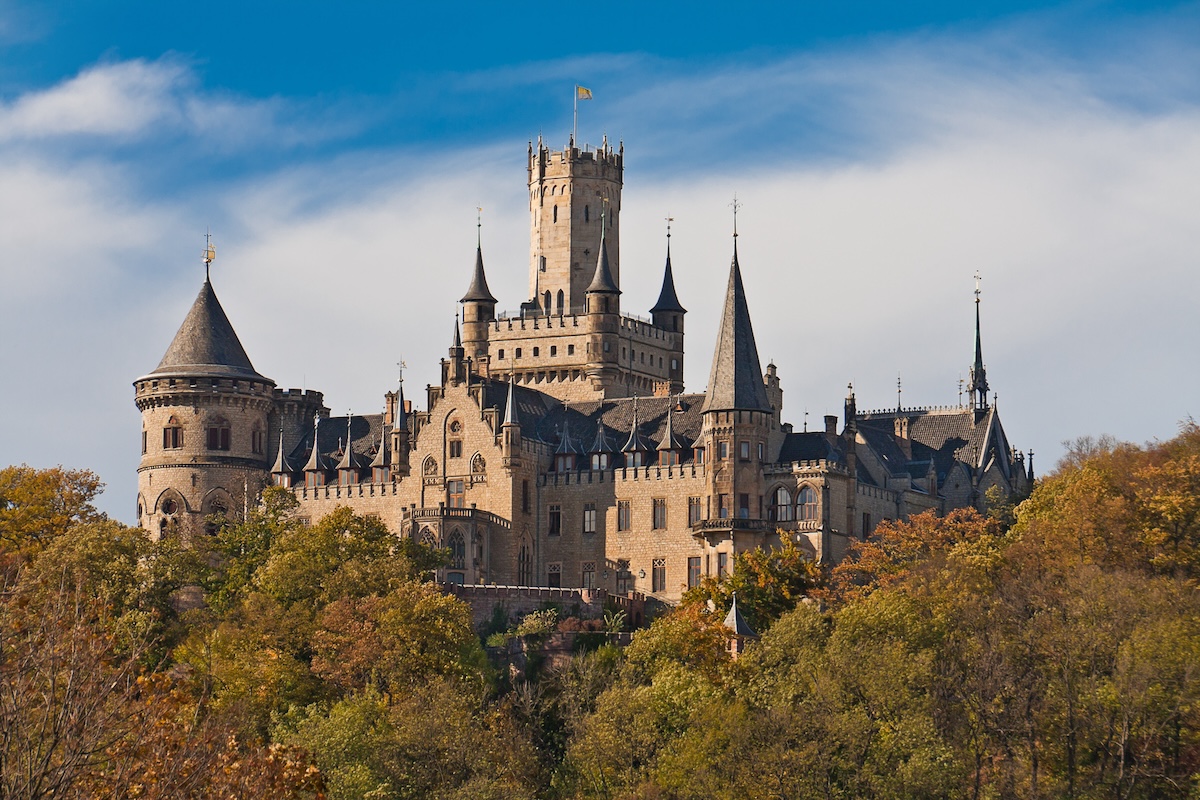
In 1857, King George V gave his wife Marienburg Castle for her 39th birthday as a token of his abiding love. Prior to the castle’s completion, the Prussians forced King George V into exile in Austria in 1866, with Queen Marie following her husband a year later. Since 2004, Marienburg Castle has been in the possession of the great-great-great grandson of Queen Marie and King George V.
Schwerin Castle
Schwerin Castle sits on an island in the main lake at Schwerin, where a castle reportedly stood as early as the 10th century. For many centuries, it was home to the grand dukes of Mecklenburg. In the 20th century, it was a college for kindergarten teachers and a museum.
Today the castle serves as a museum and as a government building for the Mecklenburg-Vorpommern state parliament. Visitors with an interest in the paranormal will want to look for Petermännchen, the resident ghost who has been spotted wearing 17th century garb. The castle, with its many towers and turrets, is considered a prime example of Europe’s historicist architecture.
Altena Castle
Originally built in the 12th century, the Altena Castle is perched high above the old city of Altena. It owes its international reputation to it being the first youth hostel in the world. It was opened in 1914. Today the castle is home to a series of 31 themed rooms, each zeroing in on a different aspect of its regional history.
Moyland Castle
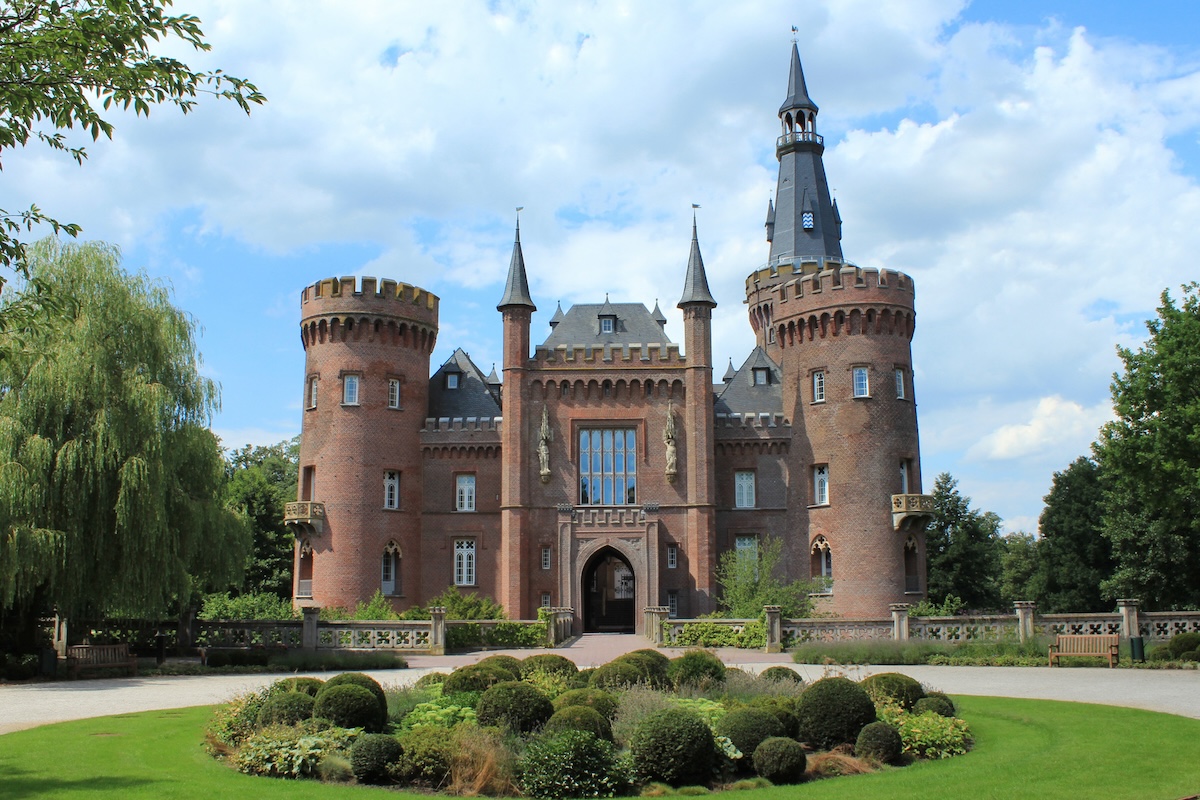
This medieval moated castle has been remodel many times over the centuries. In the 19th century, the master builder of Cologne Cathedral Ernst Friedrich Zwirner reconstructed the castle in the neo-gothic style. The name Moyland (which means ‘beautiful country’ in Dutch) was coined by workers from the Netherlands, who were hired to drain the surrounding wetlands.
Gudenau Castle

Gudenau Castle was built in the year 1200 and belonged to the Counts’ Estate of Drachenfels from the 15th century onwards. During World War II, the lovely four-wing castle was destroyed. Today the castle has been restored and is under private ownership.
Drachenburg Castle
Schloss Drachenburg, a fairy tale castle built in the 1880s, is an architectural mishmash that contains a fake organ, a reproduction of a Louis XIV throne and tacky murals. The financier who had the castle built, Stephan Sarter made his fortune helping to arrange the financing for the Suez Canal. One of the wall paintings features him as a medieval knight on horseback.
Nürburg Castle

High towering above the Eifel Region is the Nürburg Castle. The castle, which can be accessed via various walking trails from Quiddelbach offers panoramic views across the region and the adjacent Nürburg Ring Race Course.
Cochem Castle
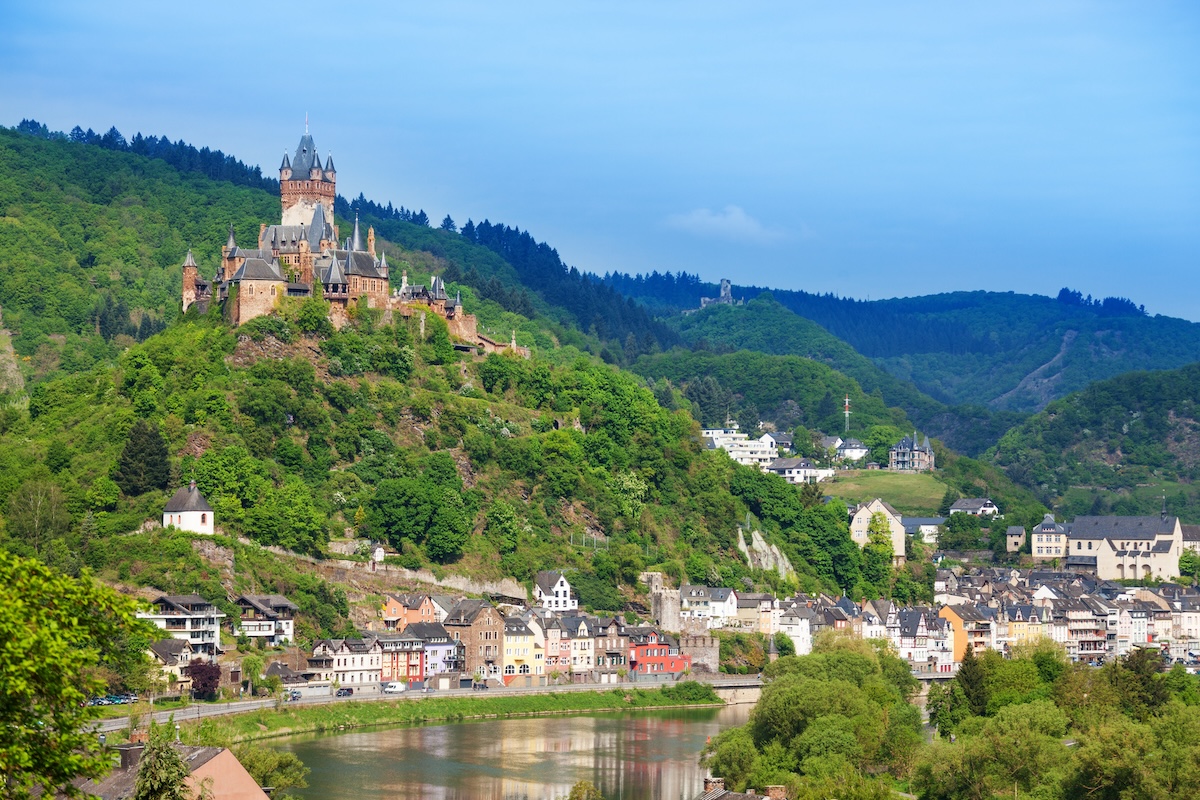
The Reichsburg Castle in Cochem was built around 1000 by a palatinate count, and later changed hands when an emperor pawned it to pay for his coronation. It was nearly destroyed in the 17th century when French King Louis XIV invaded the region.
The castle was rebuilt in Neo-Gothic style. Sitting on a hill overlooking the Moselle River, the castle has an impressive display of Renaissance and Baroque furniture.
Metternich Castle
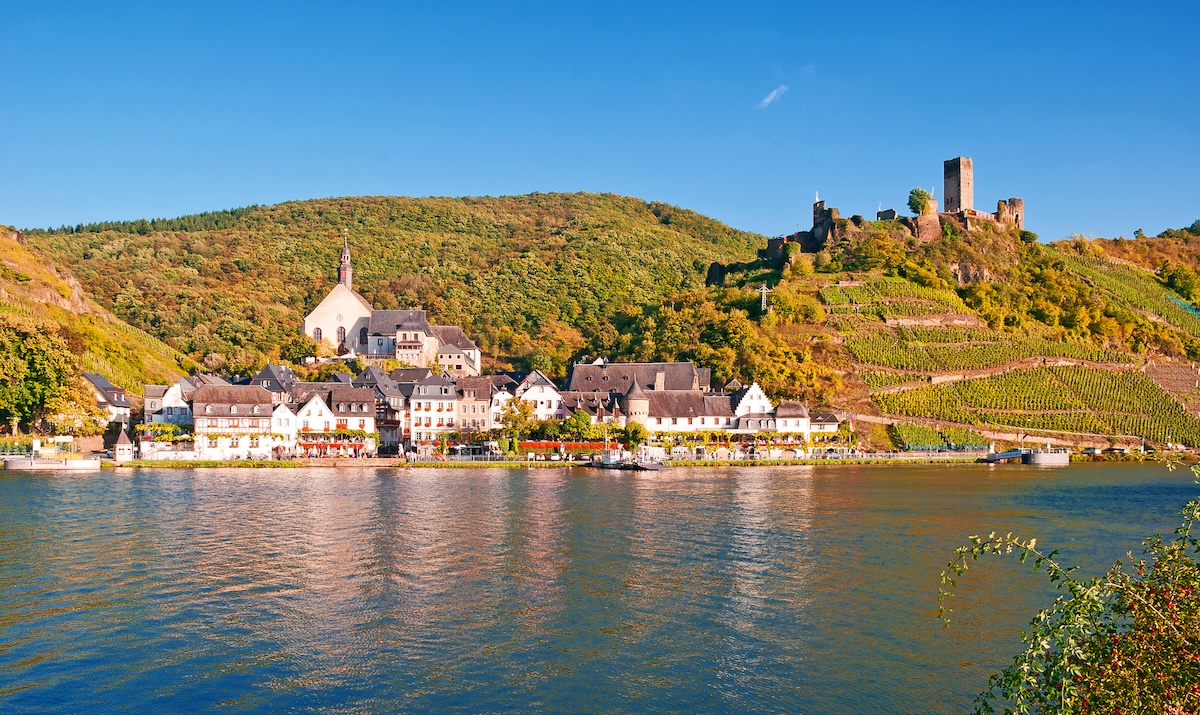
Metternich Castle, now in ruins, is located near the town of Beilstein on the river Moselle. The history of the castle can be traced back to 1268 when it was first mentioned. In 1637 the castle became the property of the House of Metternich, hence its current name. Fifty year later, during the Nine Years’ War, the castle was devastated by French troops.
Burg Eltz
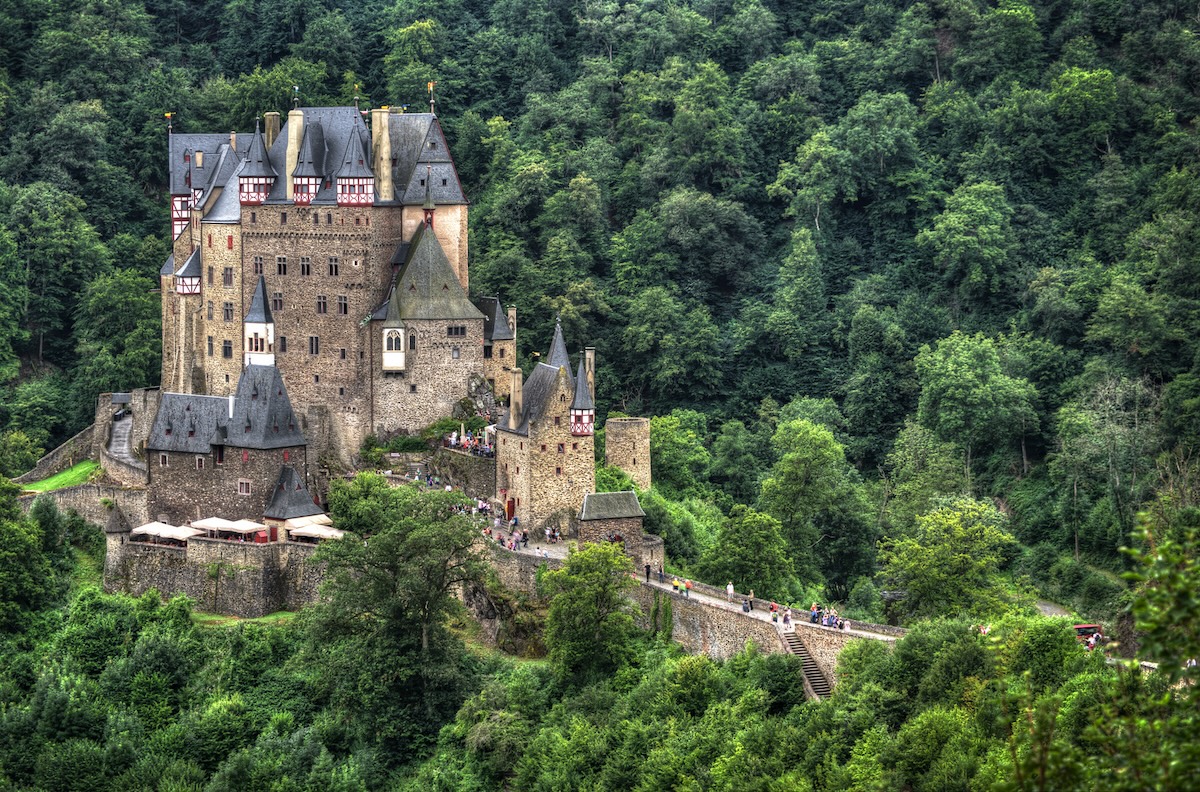
Burg Eltz Castle is situated near the Moselle River between Koblenz and Trier. It has been the ancestral home of the Rübenach, Rodendorf and Kempenich families since it was built in the 12th century; the castle still boasts some of the original furnishings.
The castle sits on a huge rock in the middle of a forest. Its medieval architecture is unique; also contributing to the uniqueness is the fact that it has never been touched by war. Its armory, filled with gold and silver artifacts, as well as porcelain and jewelry, is considered one of the best in Europe. The castle’s exterior was featured in the 1979 movie, “The Ninth Configuration”.
Stolzenfels Castle

Stolzenfels Castle dates back to the 13th century when it served as a toll station for boats and ships traveling on the Rhine River. The castle was not very successful as a defense mechanism as it was occupied by foreign troops several times and destroyed by the French in the late 17th century. Located near Koblenz, it was later restored and used as a summer palace by the King of Prussia. Following more restoration work in the 21st century, the castle opened to the public in 2011.
Reichenstein Castle
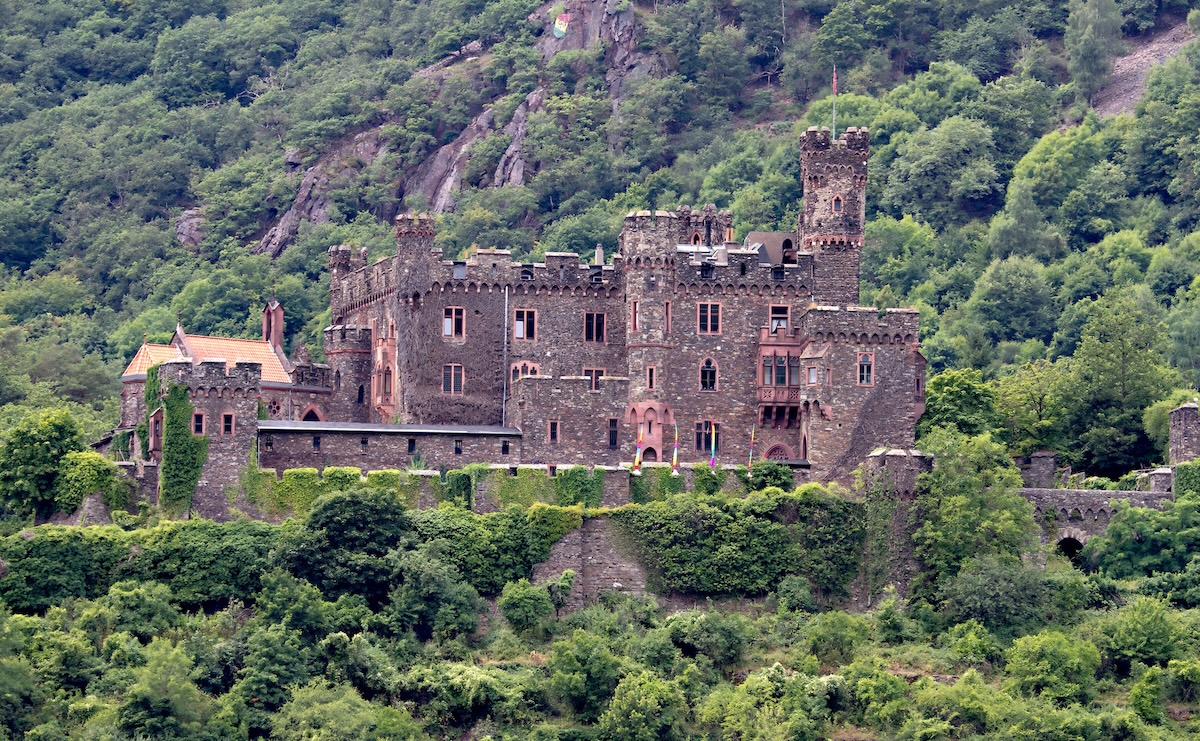
Schloss Reichenstein is a truly atmospheric castle, with dark stone walls, narrow windows and crenellated battlements that bring its turbulent history vividly to life. It was initially built to protect the city of Aachen from invasion in the early 11th century. Towards the end of the following century, several generations of barons who lived at the castle began to impose illegal tolls on ships and carriages in the Rhine area, and engaged in a reign of terror until they were deposed in 1253 by the Rhine League, and the castle was destroyed. In the next centuries it was destroyed and rebuilt on numerous occasions, in different styles.
Rheinstein Castle

Burg Rheinstein was built in the early 10th century on a rocky hilltop above the Rhine River in Germany’s picturesque Lorelei Valley. During the romantic period in the 19th century, Prince Frederick of Prussia bought the castle and had it rebuilt. Today, the castle is privately owned by the Hecher family and open to the public 10 months out of the year.
Stahleck Castle
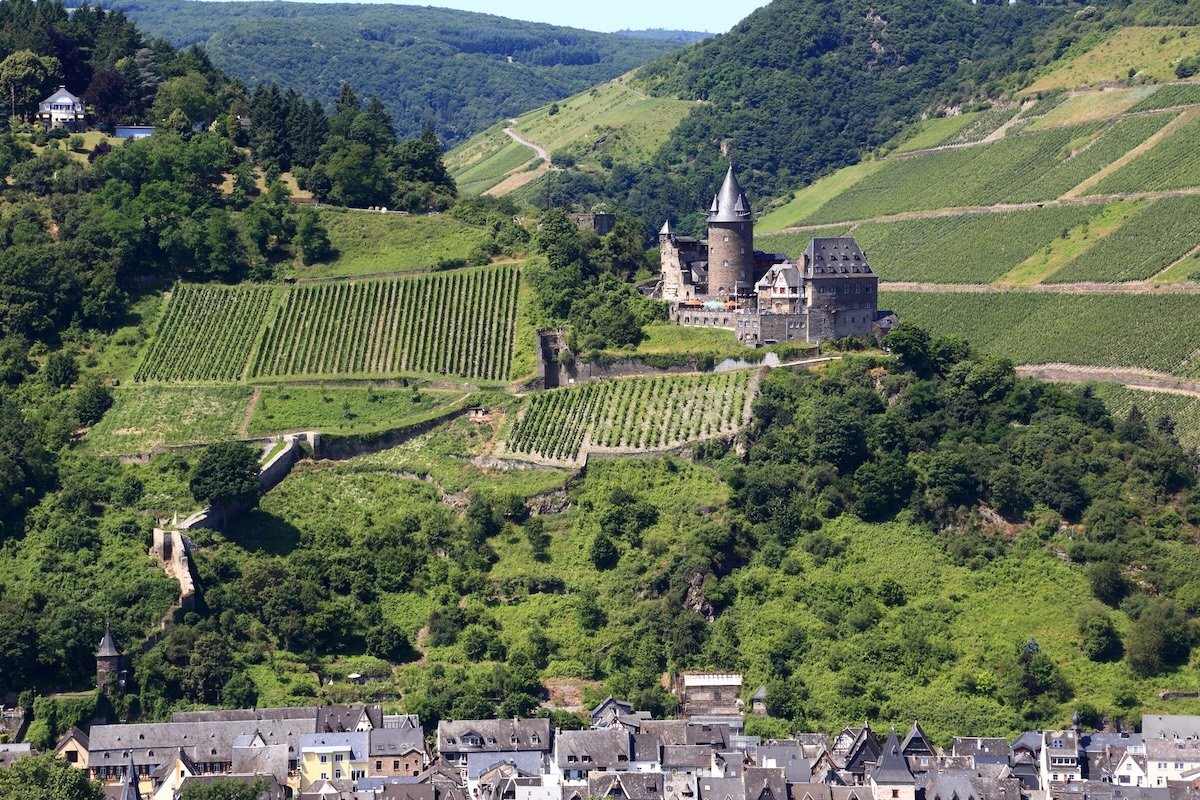
Stahleck Castle was acquired by emperor Barbarossa in 1190, who gave it to his brother Konrad. In 1689 the French blew up the castle. It was not until the 20th century before the castle was restored to its current impressive size. Today the former castle of the Hohenstaufen dynasty is a youth hostel.
Schönburg
Schönburg Castle in the Upper Middle Rhine Valley is more than 1,000 years old or would be if it had survived the centuries intact. The castle, which sits on a hill above the town of Oberwesel, was destroyed by the French in 1689. It lay in ruins for 200 years until a family bought and restored it. Once a place where people paid tolls to travel on this section of the Rhine River, it is today a hotel and restaurant.
Lahneck Castle

Overlooking the confluence of the Rhine and its tributary the Lahn stands the thirteenth century. In June 1851, while on holiday with her family, the 17-year-old Idilia Dubb climbed the abandoned castle’s high tower, when suddenly the wooden stairs collapsed behind her. Nobody heard her crying and calling from the tower. When she did not return, the police were contacted and an extensive search was instigated. However, no trace of her could be found and eventually her grieving family returned to Scotland.
Several years later construction workers found a skeleton at the top of one of the towers. Along with the bones, they found pages of a sketchbook owned by Idilia. On the pages, she had recorded the horror of her final days.
Marksburg

Originally named Burg Braubach, The Marksburg rises high above the right bank of the Rhine River, crowning a cone-shaped hill overlooking the town of Braubach. The Marksburg is the only castle on the Middle Rhine to escape destruction or ruin. The castle had some additions in the 17th and 18th century, but maintains its medieval character.
Pfalzgrafenstein Castle

Built in 1327 by Ludwig the Bavarian, the Pfalzgrafenstein Castle on the Falkenau island served as a toll station until 1866. Unlike the vast majority of Rhine castles, the castle was never conquered or destroyed, withstanding not only wars, but also the natural forces of ice and floods by the river.
Berwartstein Castle
Berwartstein Castle is located on a pinnacle of rock in the southern Rhineland-Pfalz region. It is unique among Germany castles because originally the only entrance was a single chimney in the rock. One person at the top could defend the castle by pulling up the rope ladder and pouring boiling oil on the head of any would-be attacker. In later years other entryways were added, and today the chimney has been blocked off from inside the castle.
Albrechtsburg
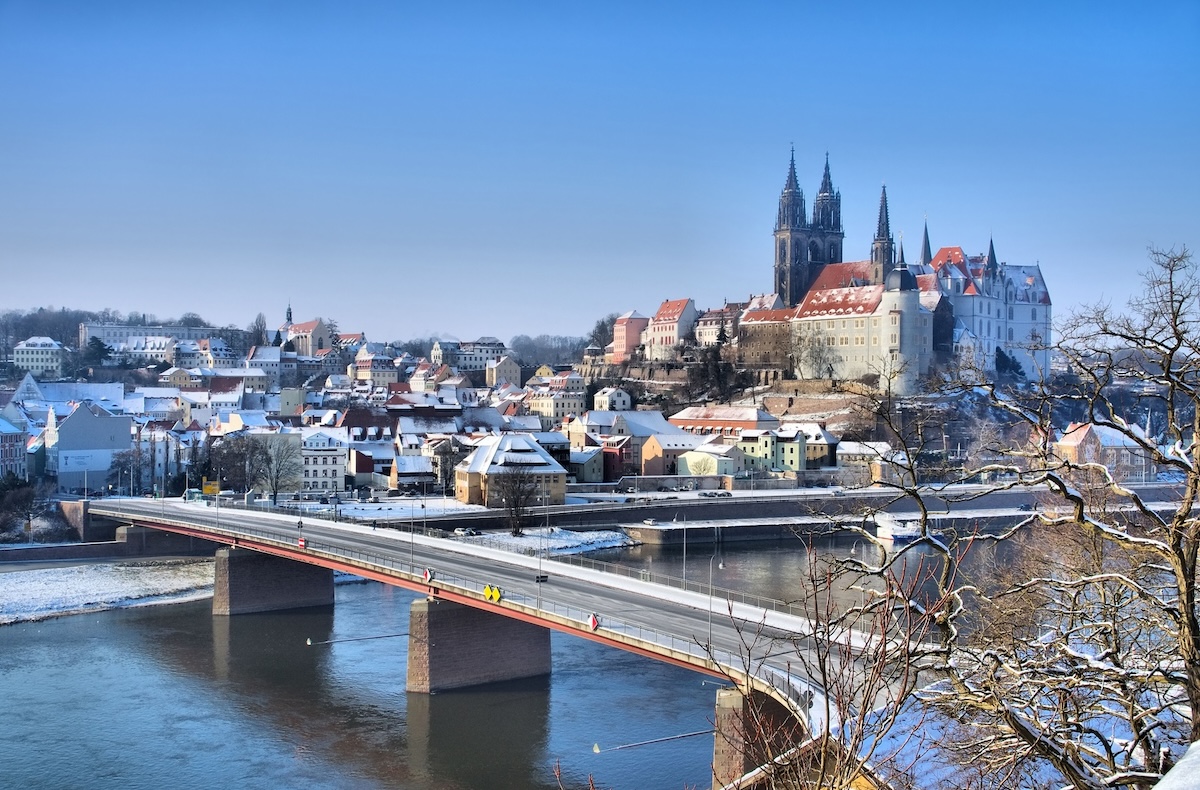
The Albrechtsburg is a Late Gothic castle that dominates the town center of Meissen in Saxony. It stands on a hill above the river Elbe, adjacent to the Meissen Cathedral.
Moritzburg Castle

Moritzburg Castle has four round towers and lies on a symmetrical artificial island. It is named after Duke Moritz of Saxony, who had a hunting lodge built there between 1542 and 1546. The surrounding woodlands and lakes have been a favorite hunting area of kings of Saxony.
Kriebstein Castle

Kriebstein is considered the most handsome knight castle in Saxony. It has a Gothic hall, a chapel, wine cellar, deep dungeon, loft and tower, living quarters, and the iconic “Kriebsteinzimmer”. This area was built in the 15th century and is a perfectly preserved room with wooden sides.
Rochlitz Castle
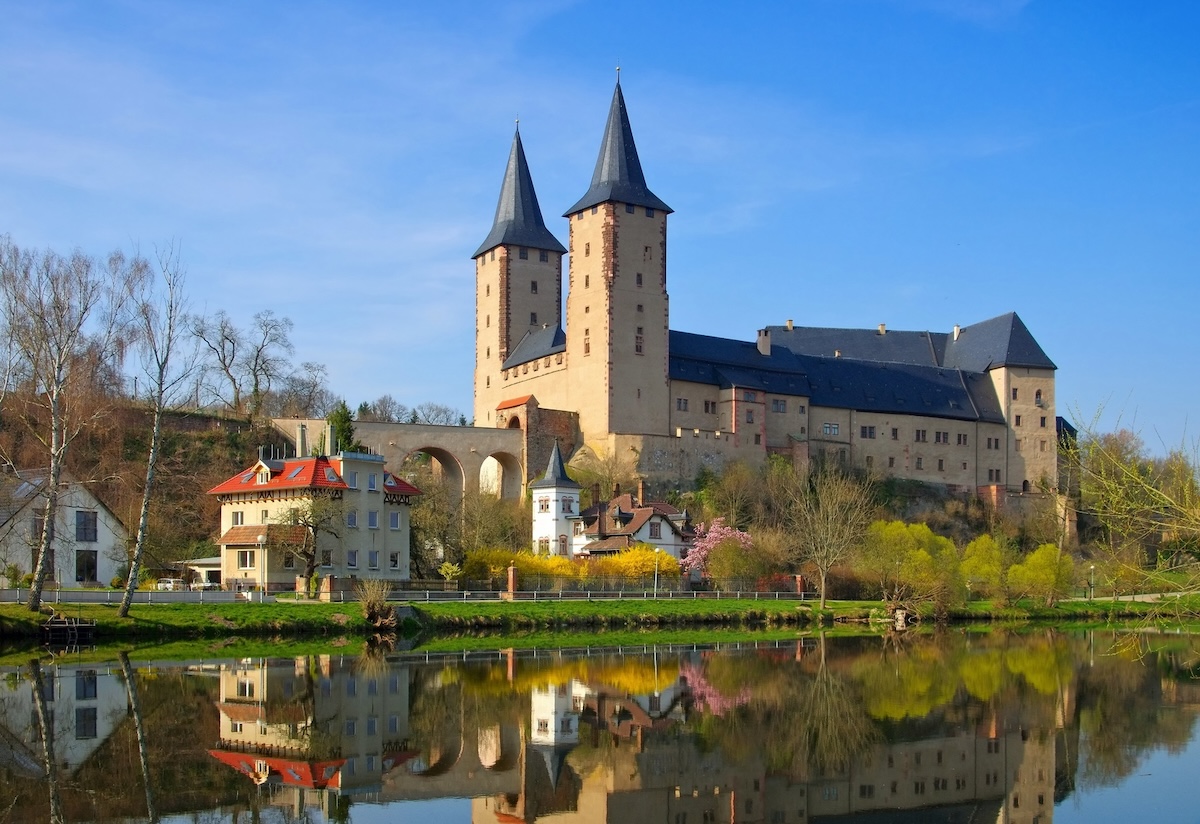
The Rochlitz Castle was built in the middle of the 10th century. Its long history saw phases of intensive use as an imperial castle, electoral residence, state prison, place of exile, boy’s school, hunting lodge as well as periods of neglect and decay.
Colditz Castle
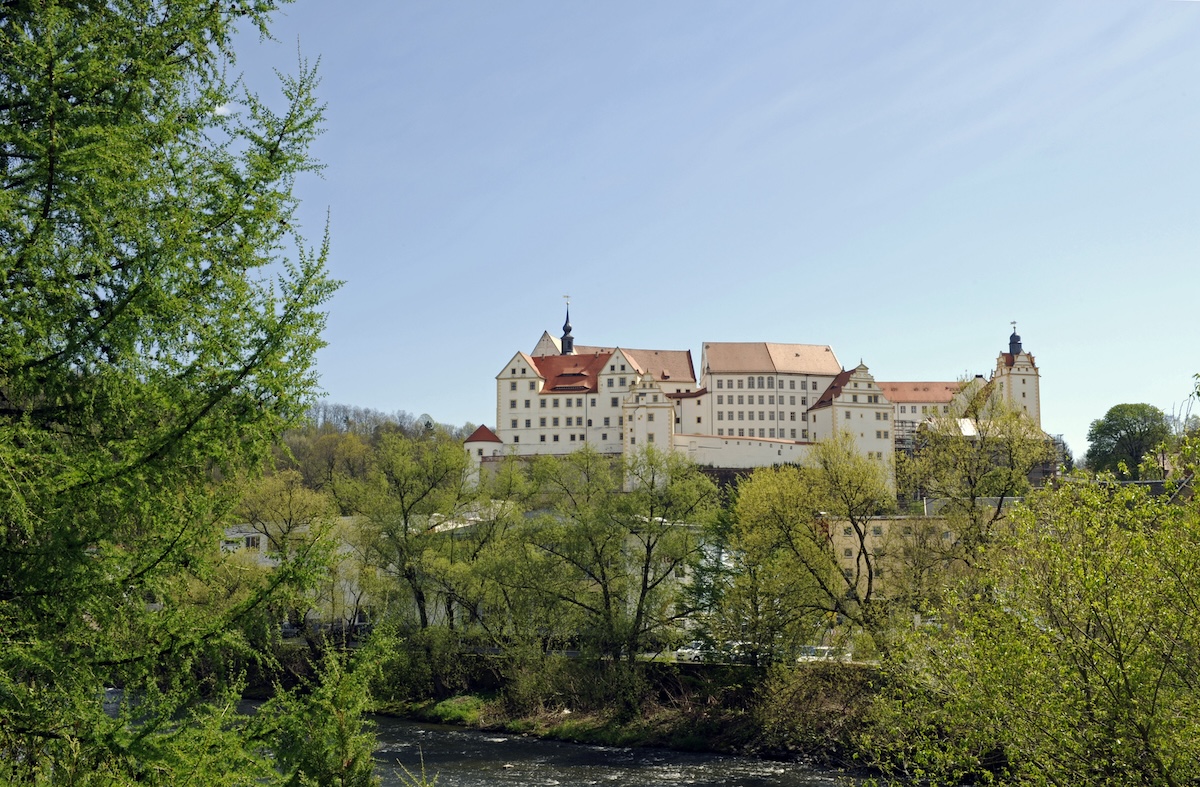
Colditz Castle, founded in the 12th century, is a stately castle overlooking Colditz, a town near Dresden and Leipzig. Its serene demeanor can be deceptive, however. During World War II, Colditz Castle served as a Nazi prisoner of war camp that housed Allied officers who had escaped repeatedly from other camps. The Allies escaped from this Saxony castle, too, though it was considered escape proof. The castle has since been restored to its pre-World War II look.
Königstein Fortress
Germany’s largest fortress, Festung Königstein, towers over the Elbe Valley in the Saxon Switzerland area. It is a popular day trip from nearby Dresden. It’s history goes back to at least the early 13th century but it only came to real importance after it became part of the March Meißen in 1459. Under Saxon control, it was expanded to a massive fortress that was never taken in battle.
Falkenstein Castle
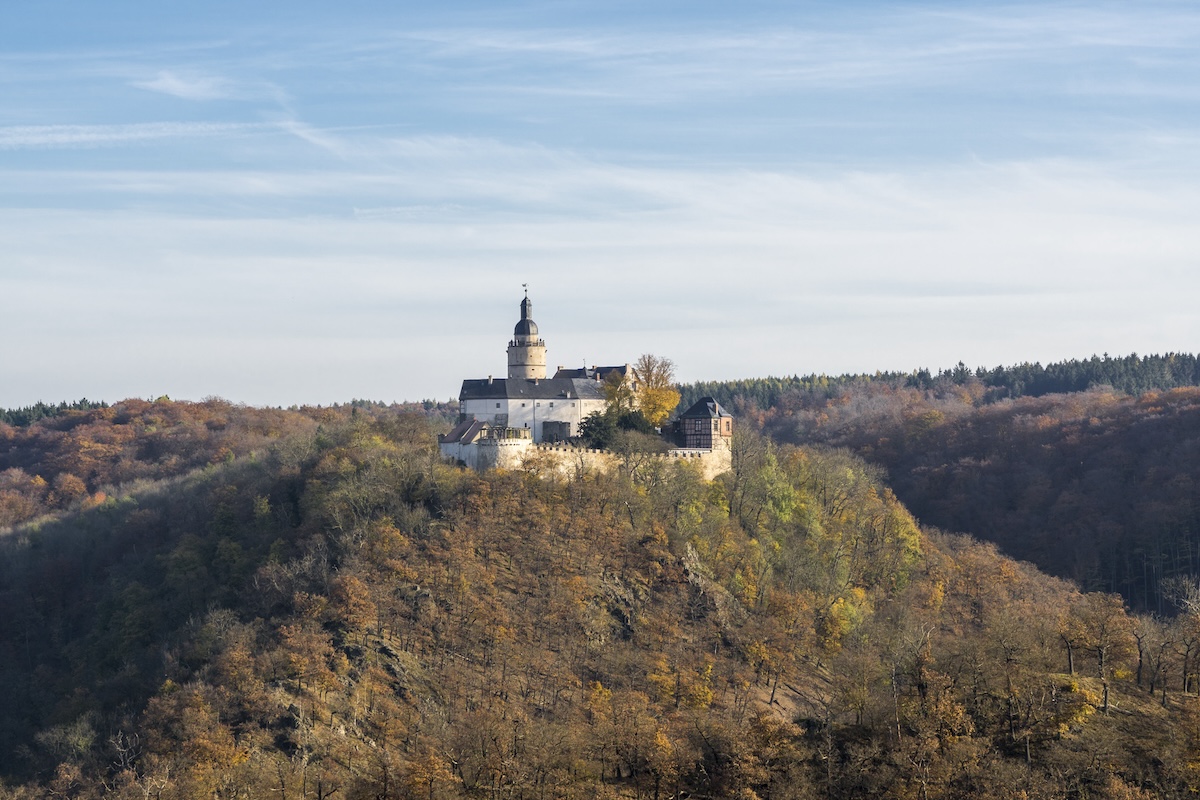
Falkenstein Castle was built between 1120 and 1180 and has been modified frequently since then, but still retains the character of a medieval castle. It has a commanding location and was never captured. Today the castle and its museum are one of the most popular destinations in the Harz Mountains.
Wernigerode Castle

Wernigerode Castle is located in the Harz mountains above the town of Wernigerode in Saxony-Anhalt. The present-day building, finished in the late 19th century, is somewhat similar in style to Neuschwanstein Castle, though its foundations are much older.
Eutin Castle

The four-winged palace originated from a medieval castle and was expanded over several centuries into a Residenz. The castle was regularly occupied until the 20th century and most of the interior has survived to the present-day. Today the castle houses a museum and is open to the public in summer.
Glücksburg Castle
Situated near the border with Denmark, Glücksburg Castle was built by Nikel Karies, a master builder from nearby Flensburg, between 1583 and 1587 for Duke Johann the Younge. It is the seat of the House of Schleswig-Holstein-Sonderburg-Glücksburg and was also used by the Danish kings. Glücksburg Castle is Germany’s largest water castle and one of the most significant family houses in northern Europe.
Wartburg
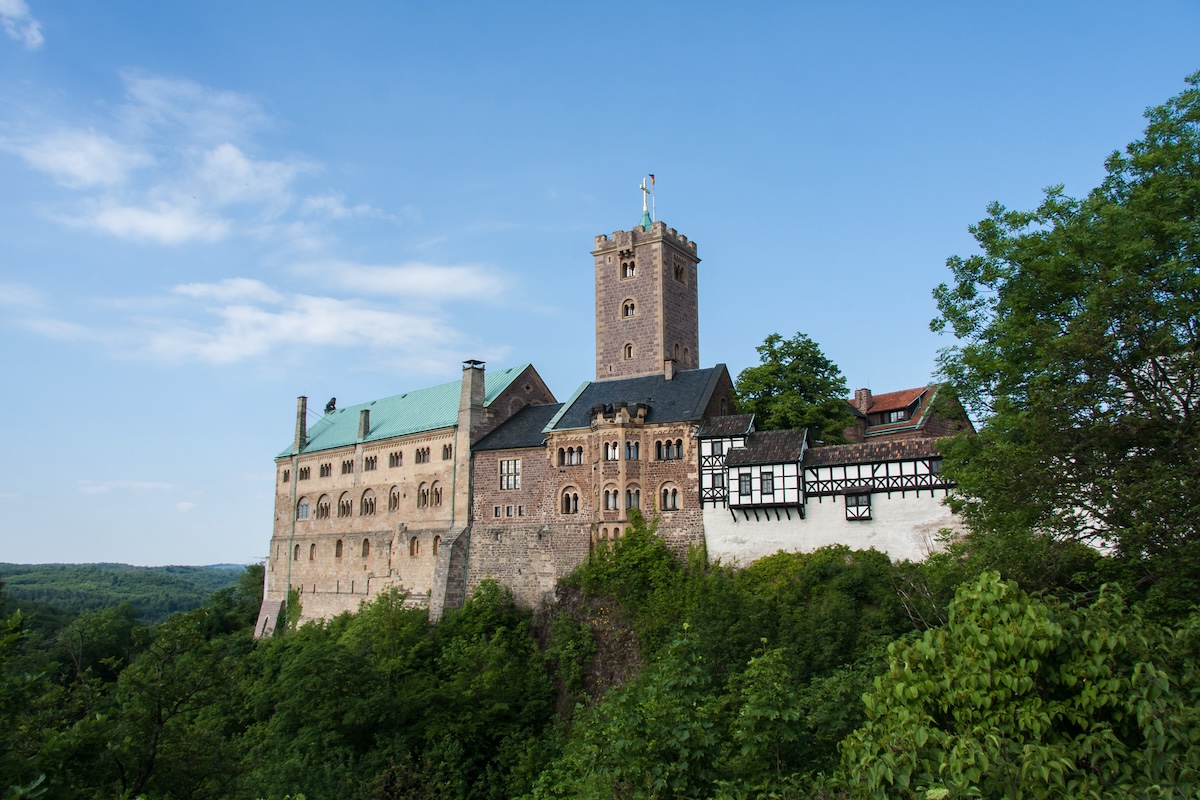
Wartburg Castle was founded in the 11th century, but its fame dates from a few centuries later. Located in Eisenach, Martin Luther hid out here while he finished translating the Bible in the early 16th century.
In the 20th century, Adolf Hitler wanted the castle to take down its cross and replace it with a swastika. One of the best preserved medieval castles in Germany, visitors have the option of taking a hike up a steep slope to reach the castle or take a shuttle bus.
55. Osterburg Castle

Situated on a mountain spur, Osterburg Castle rises above the town of Weida. The castle was built as a fortification from 1163 to 1193 by Steward Heinrich I. The 54-meter (177-foot) high Romanesque keep is one of the oldest surviving keeps in Germany.

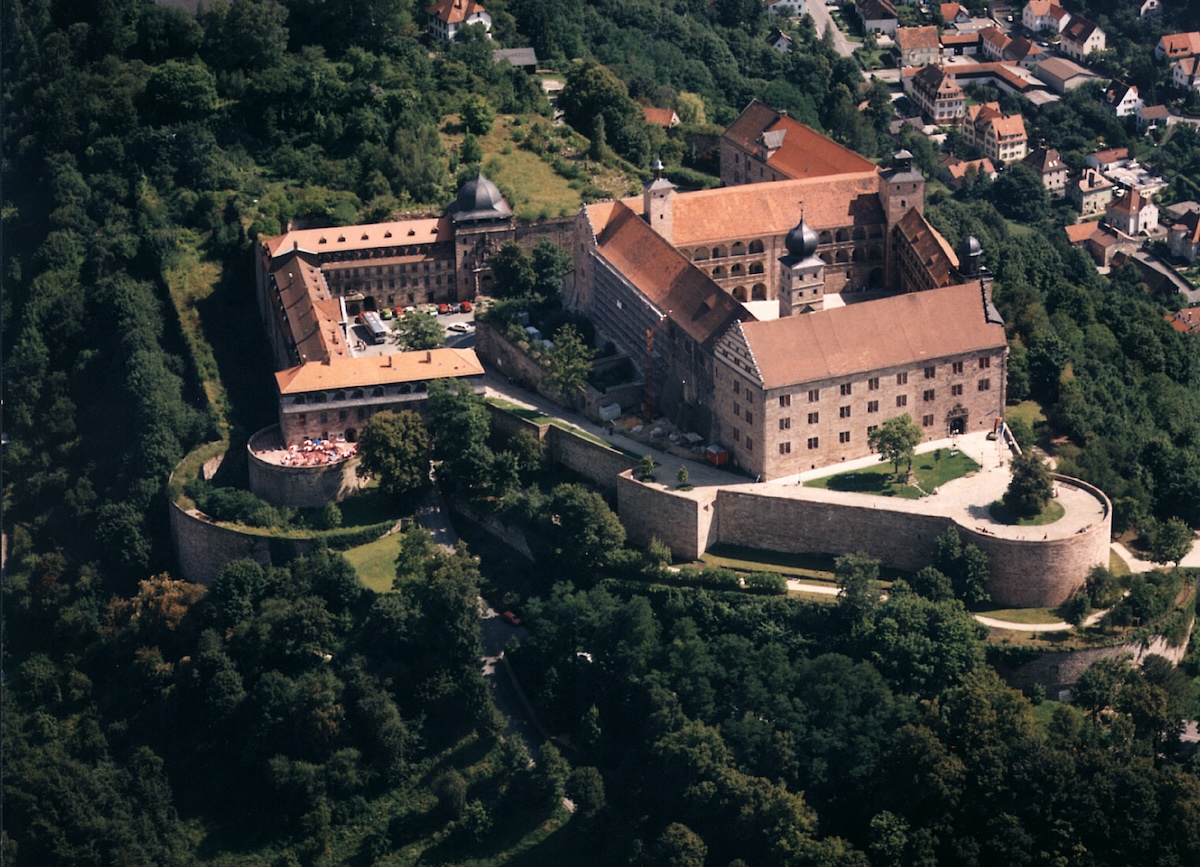
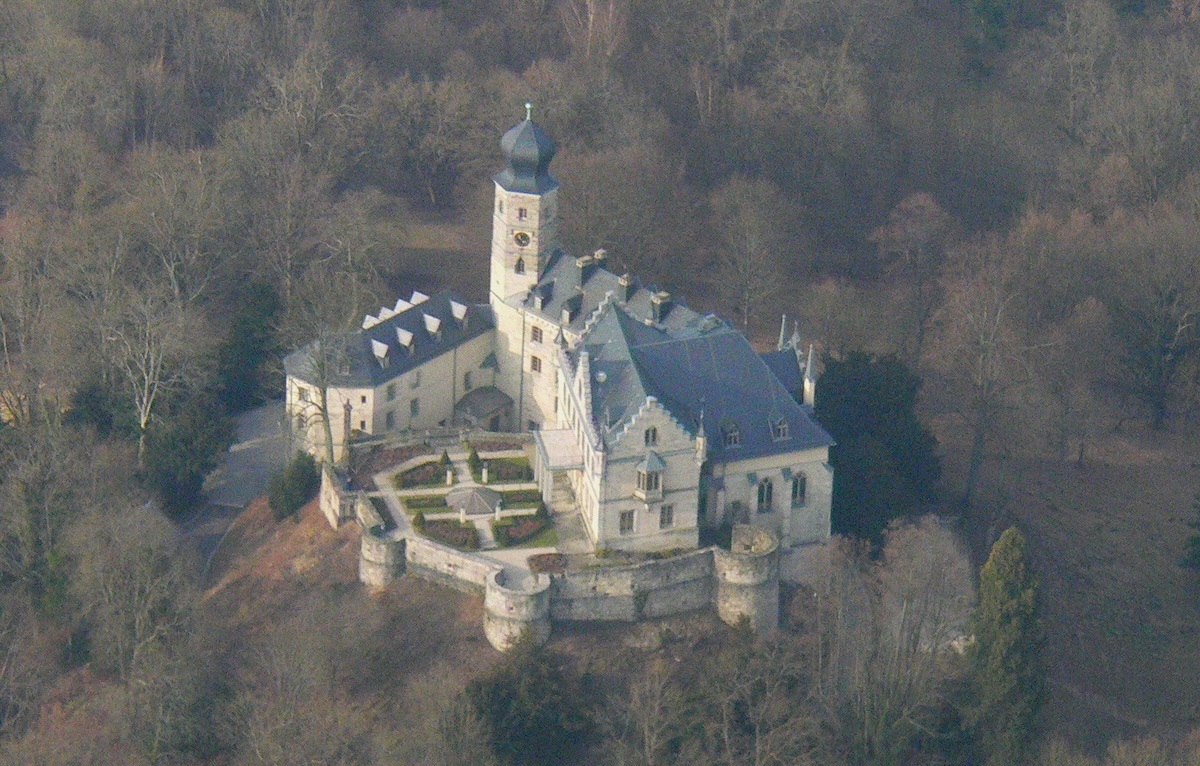
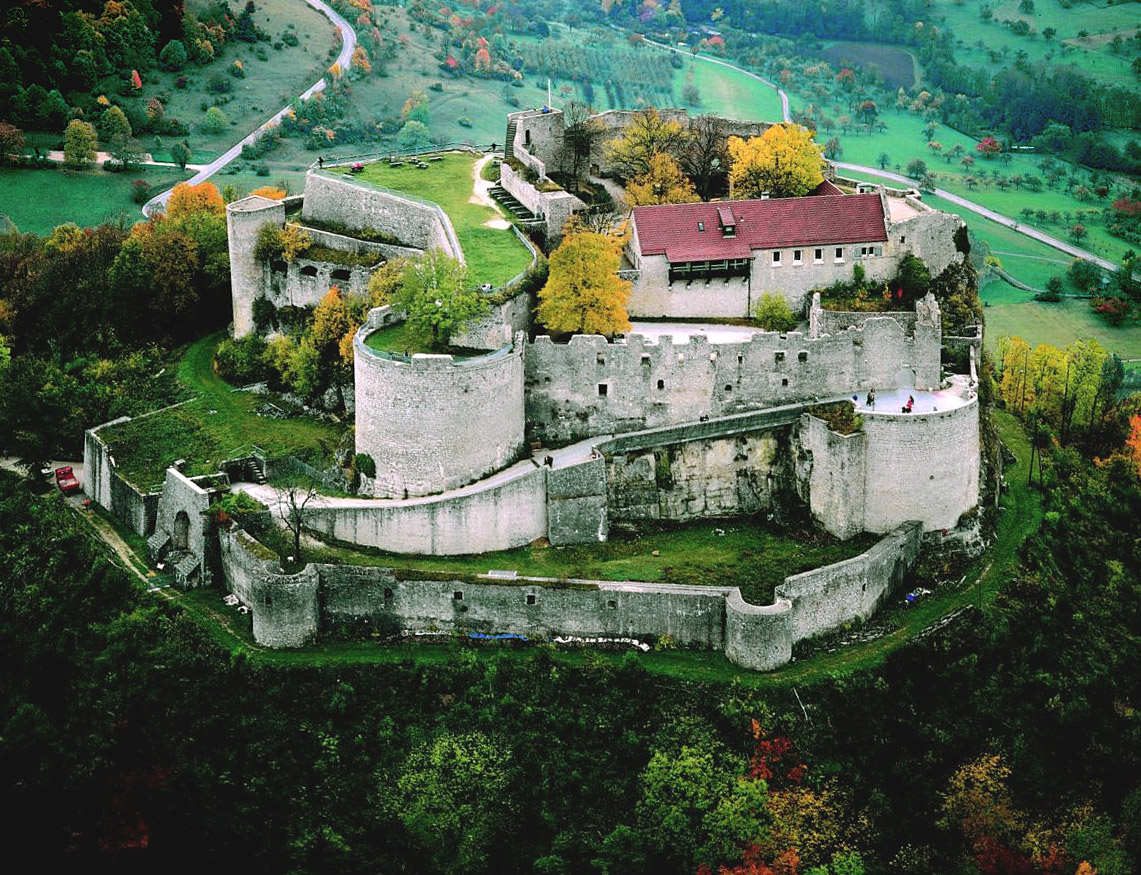

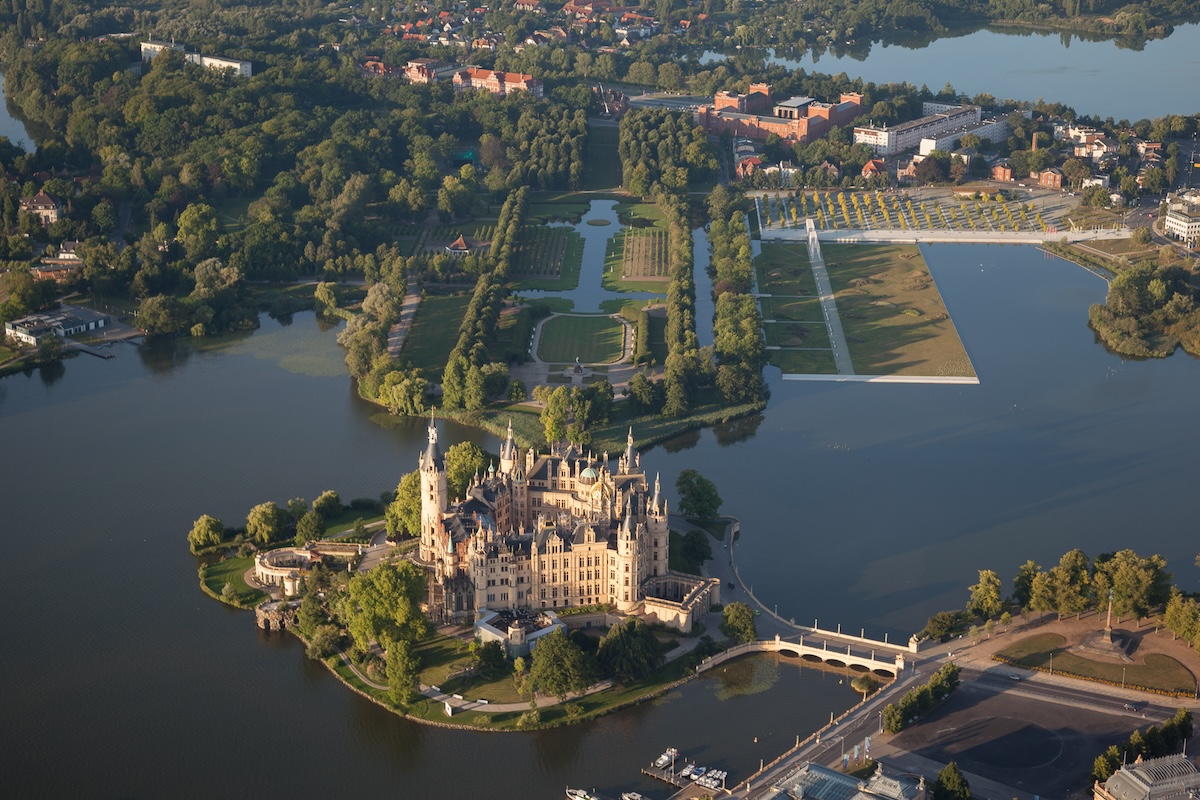
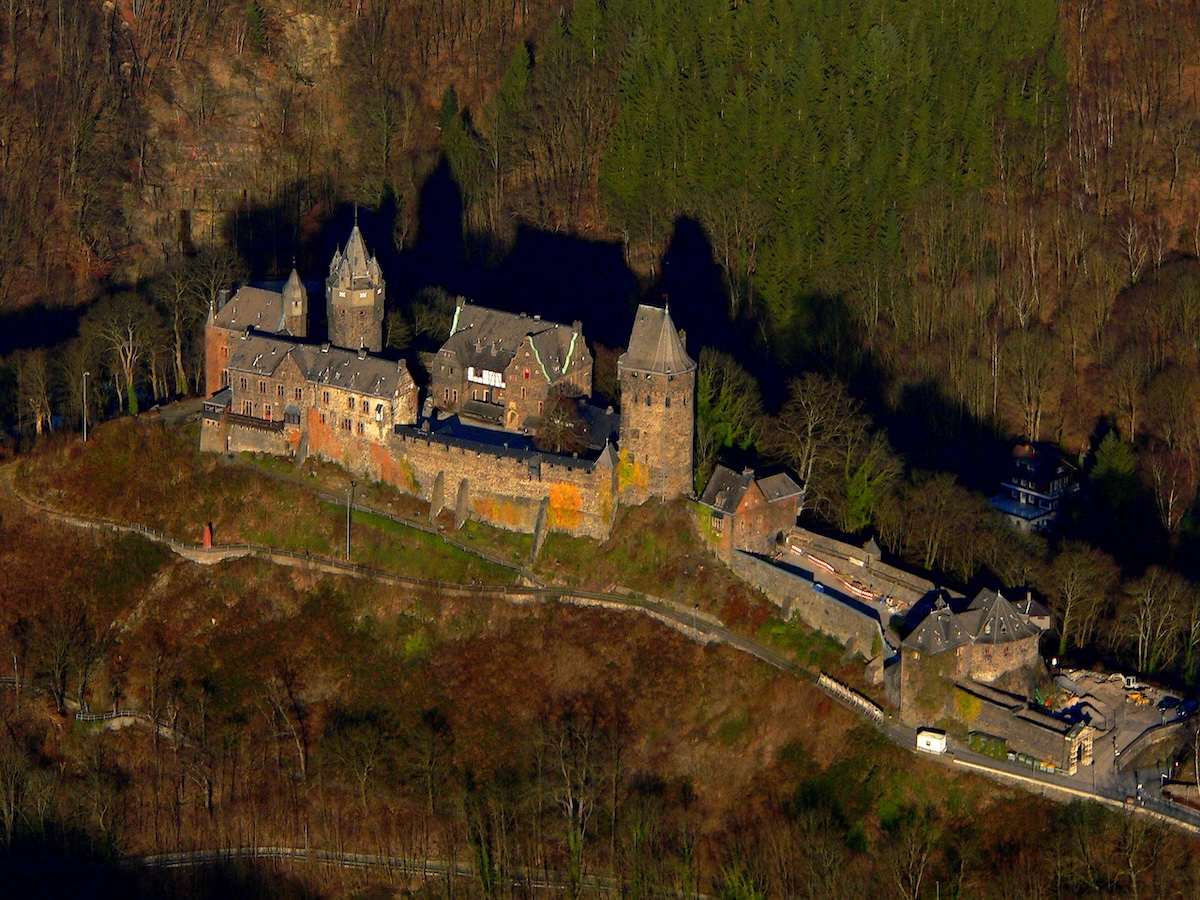


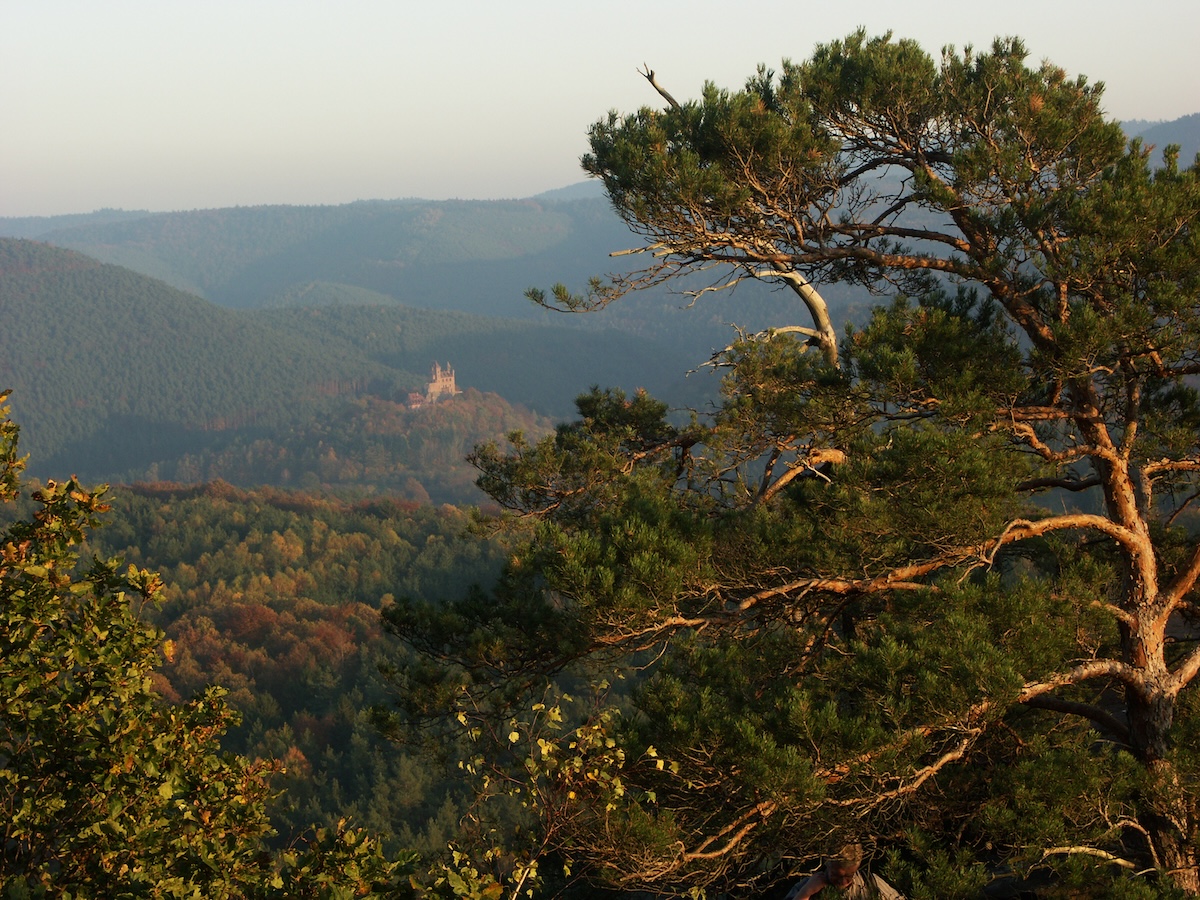
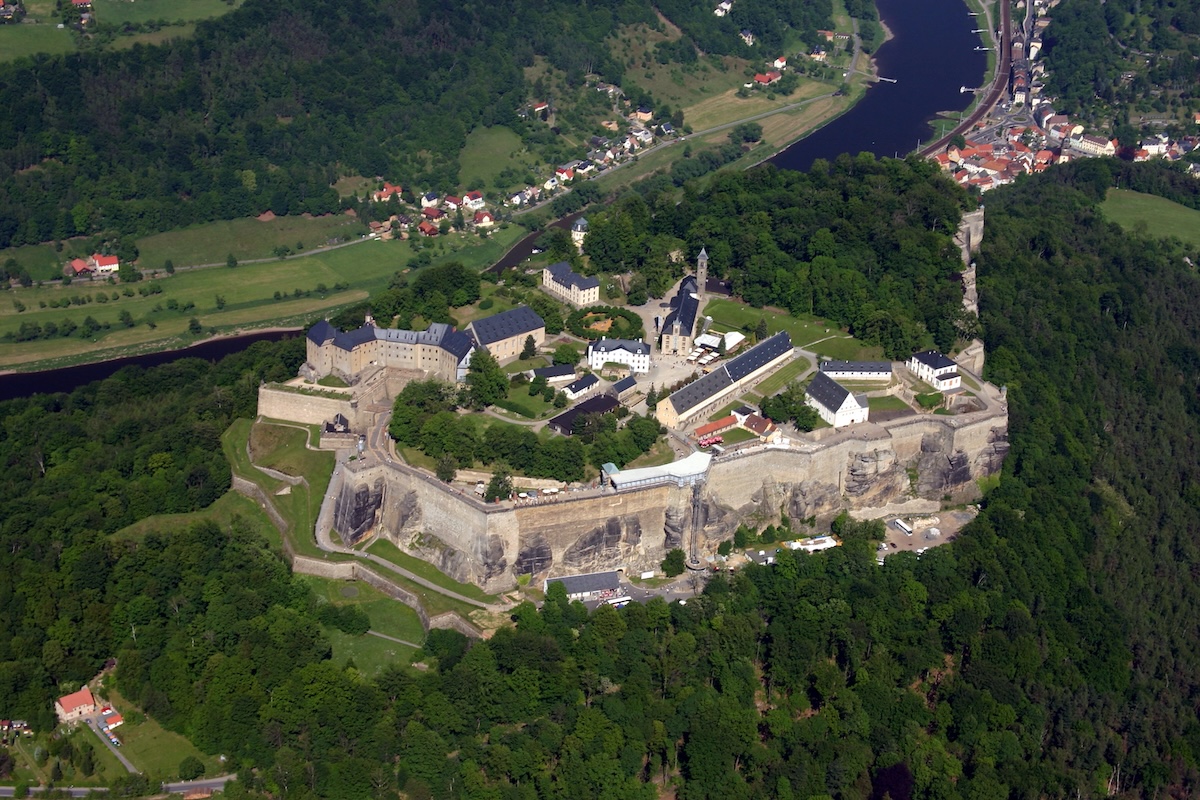



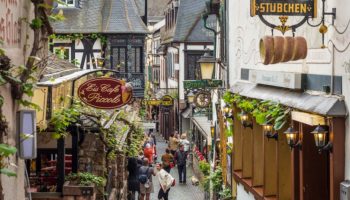
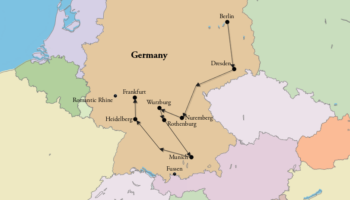
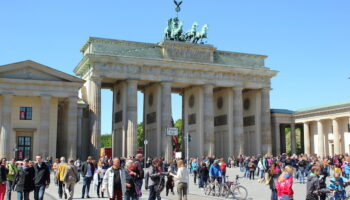


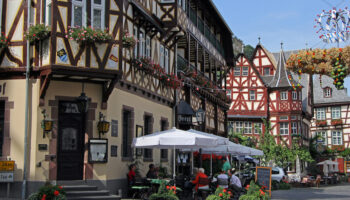

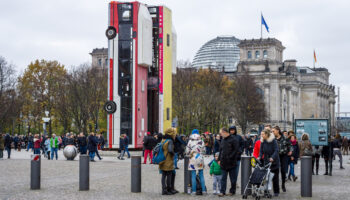
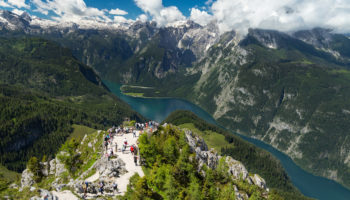
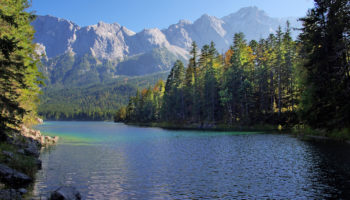
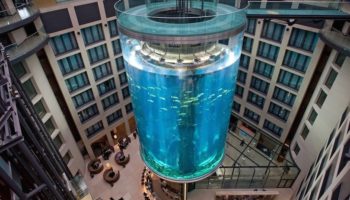
Neuschwanstein castle and Schwerin castle are my favorites because the styles are beautiful!!!!
there are many more German castles east of the Oder Neisse River.
My fave castle ever is the Neuswanstein castle! It is so beautiful!!!
I’d like to add the Bastei and Felsenburg (Rock Castle) Neurathen to the list: https://de.wikipedia.org/wiki/Felsenburg_Neurathen (German article; the English version is LOTS shorter). It is very different from the castles shown here, but incredibly fascinating in its own right, and set in a beautiful landscape in the far east of Germany. If you visit Dresden (or even the Czech Republic, which is right next door!), make sure to take a detour there!
Also very worthy of this list is Wurzburg Residenz, Schloss Johannisburg (Ashaffensburg), and Lowenburg Castle in Wilhelmshöhe. All are beautiful and worthy of your time.
Thanks for the recommendation, Kai! Looked it up and it’s beautiful. I’m going to put this on my list of “must visit” castles here.
I think you forgot the beautiful “Castle Drachenbug in Königswinter NRW” . Castle/Schloss Drachenburg is a fantasy castle much in the same vein as the gloriously wasteful Schloss Neuschwanstein near Munich, which you have already presented in your great article.